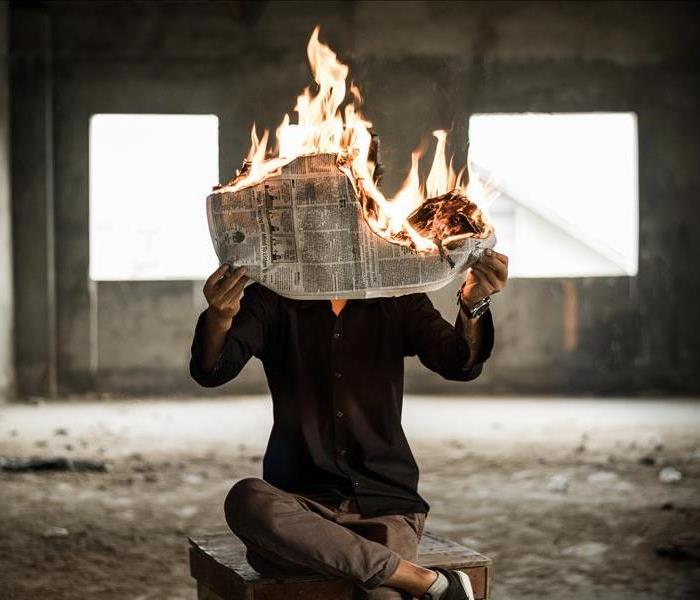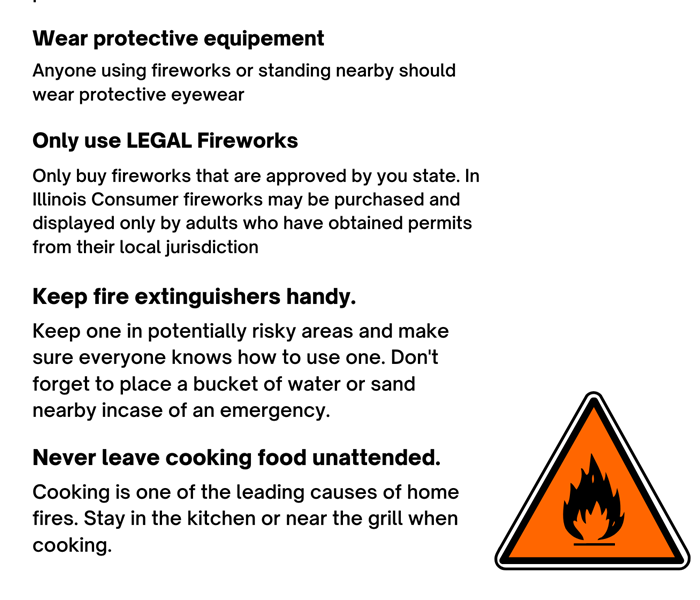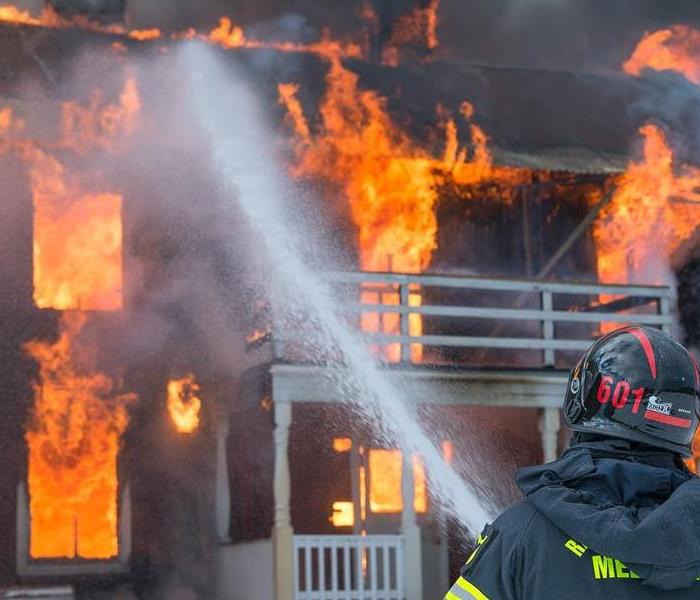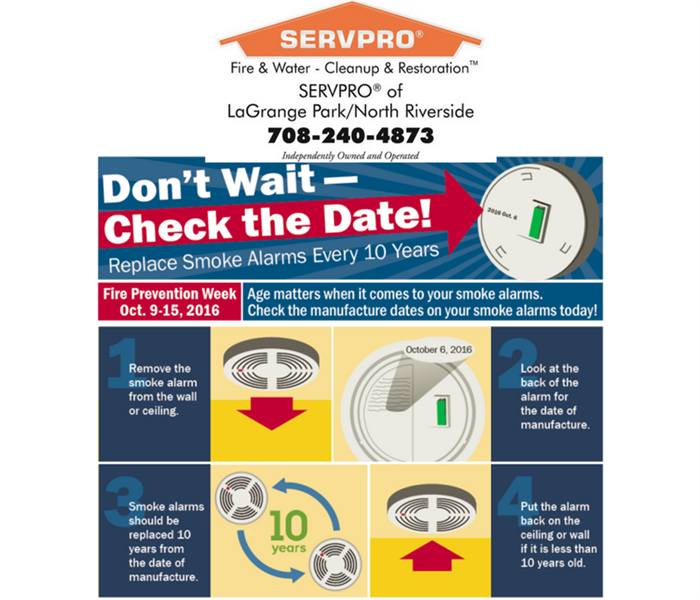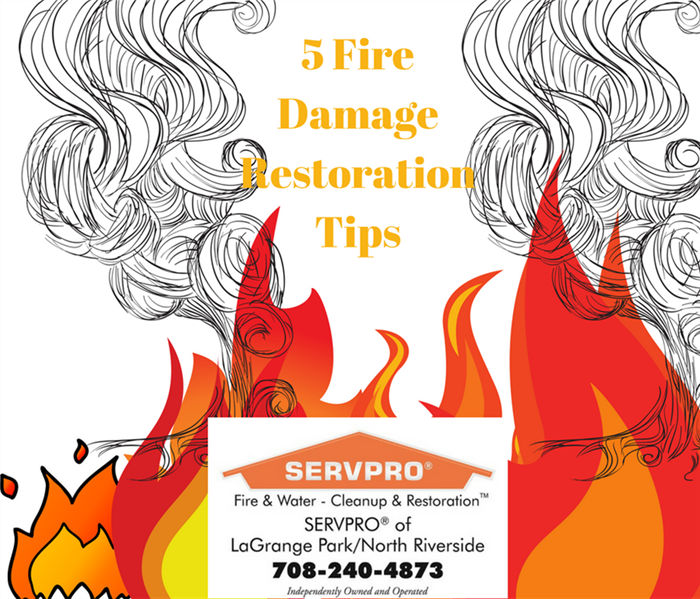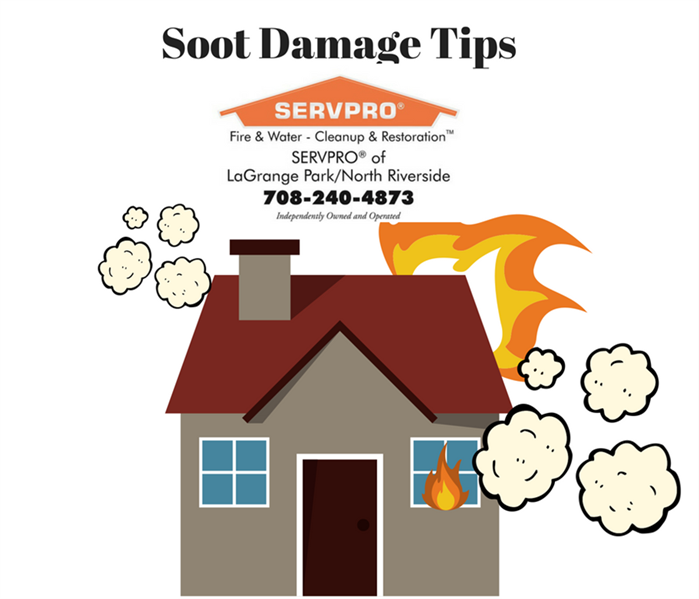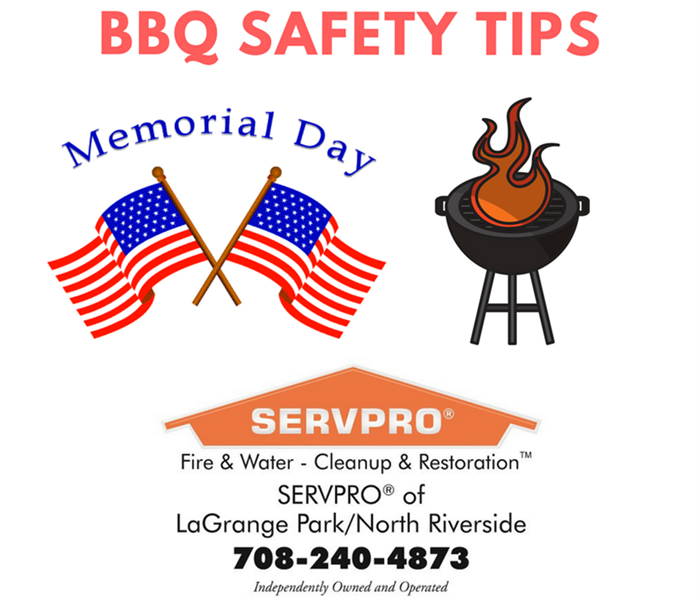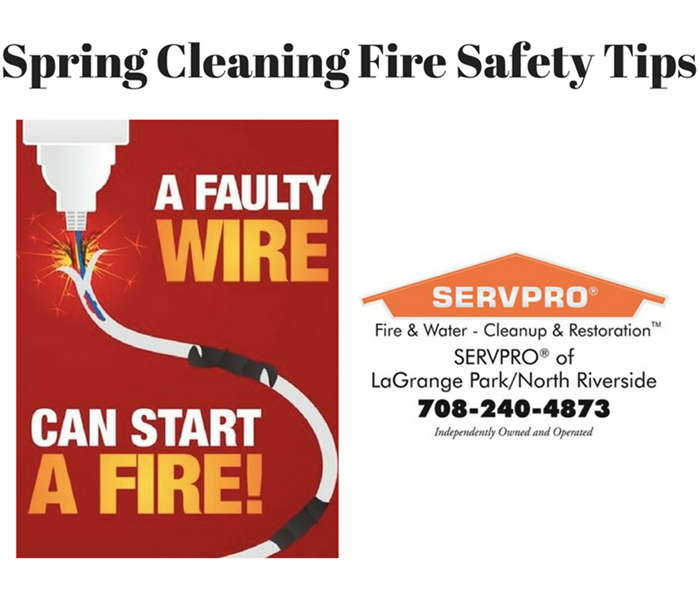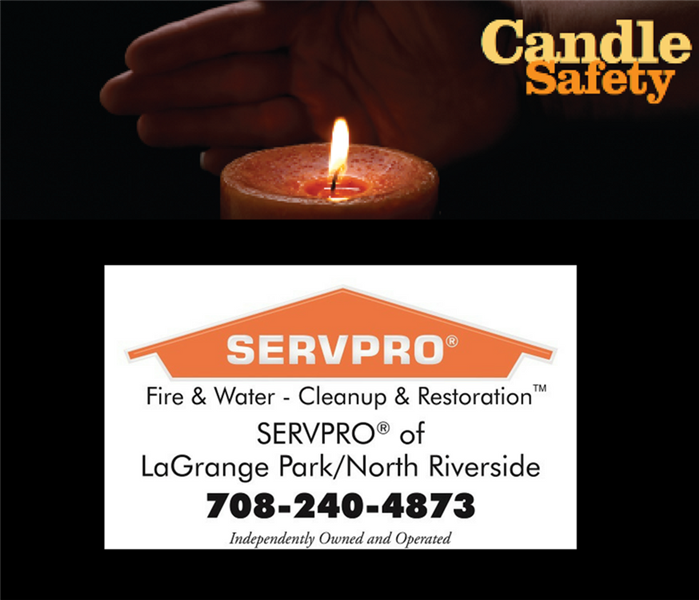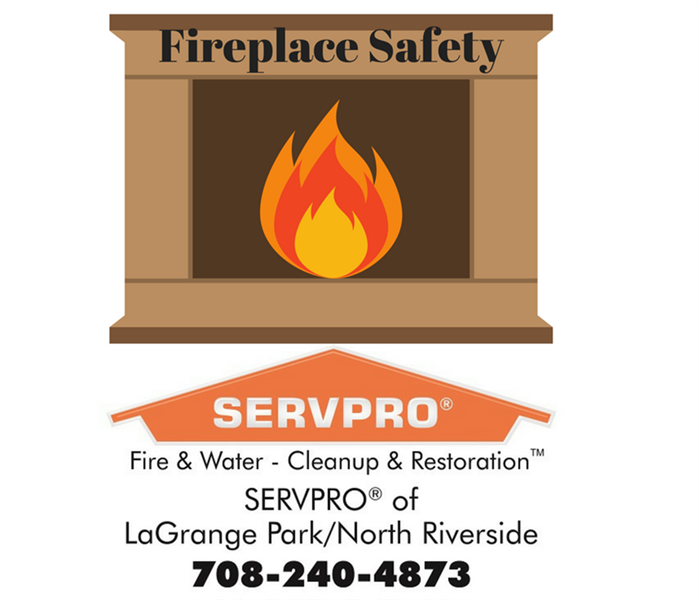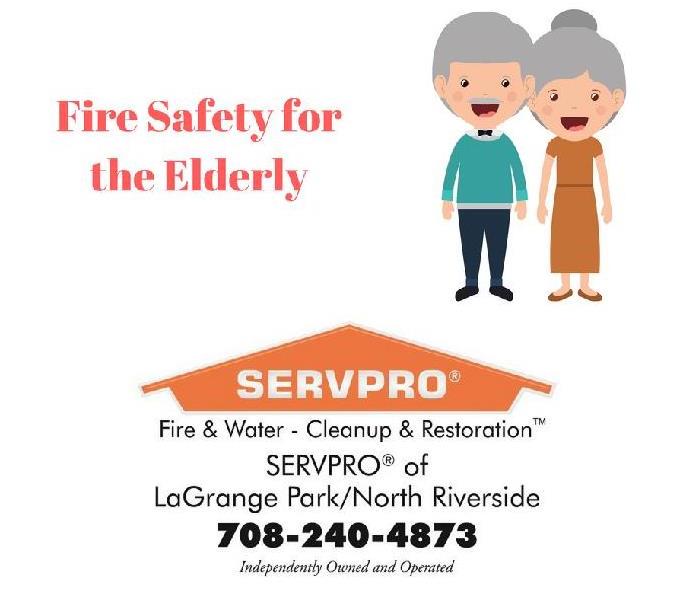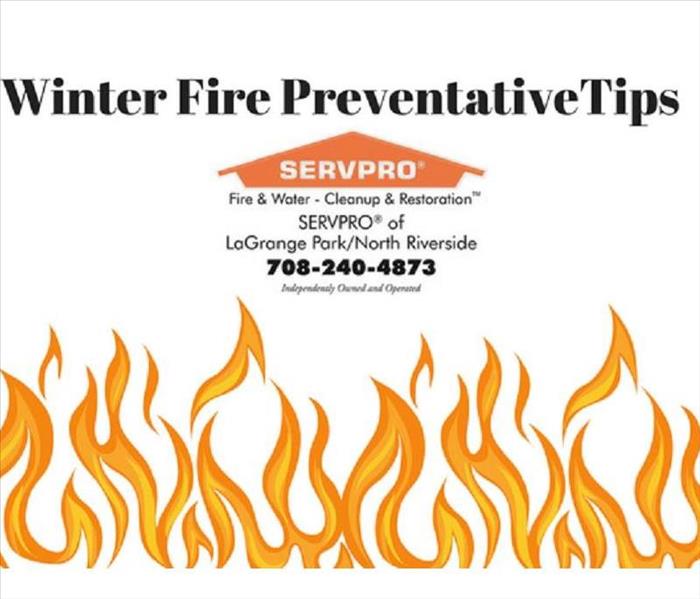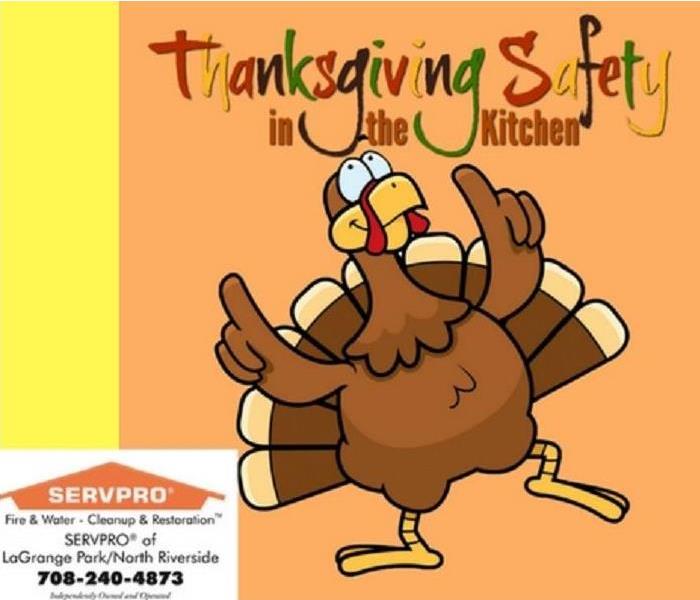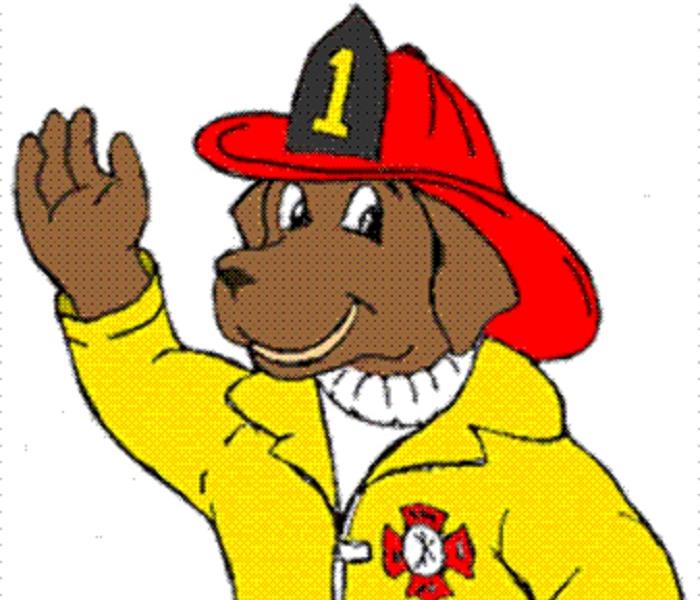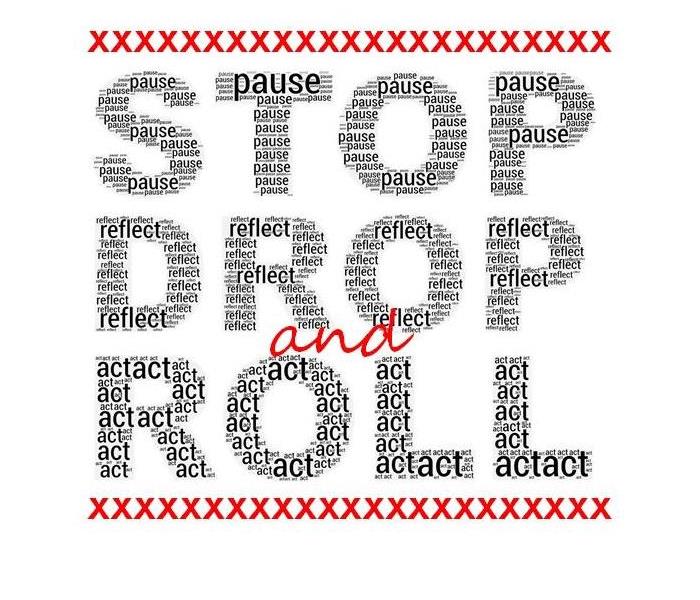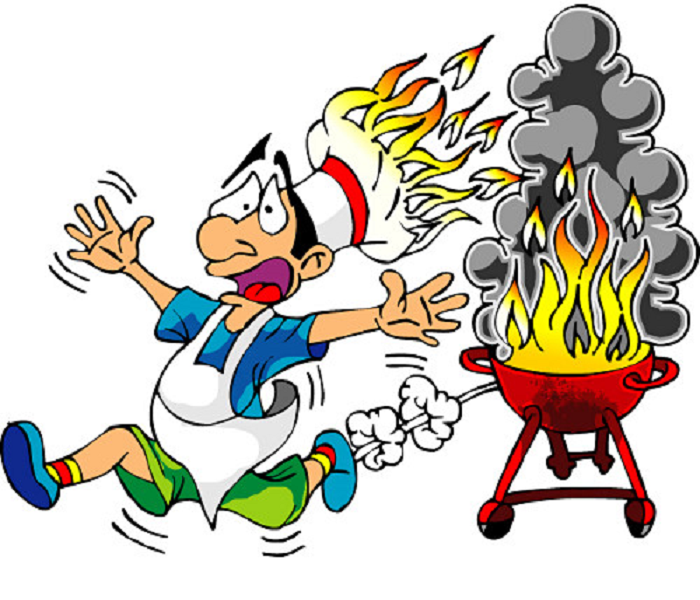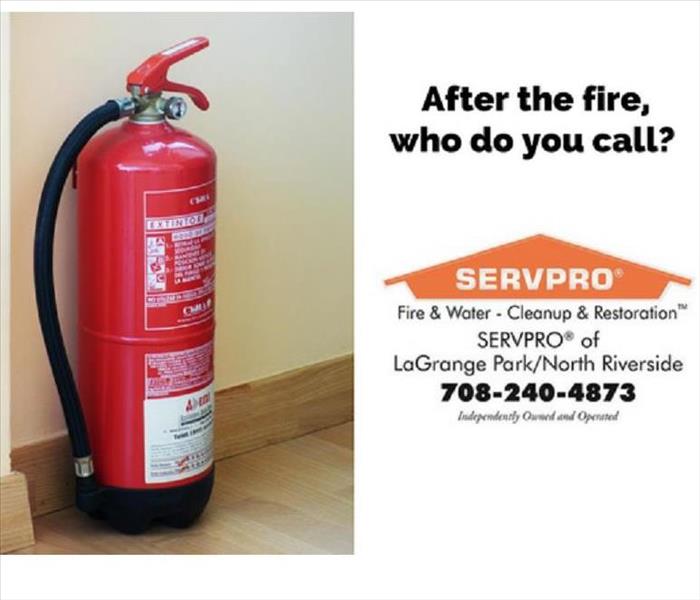Archived Fire Damage Blog Posts
Berwyn Smoke and Soot Cleanup
9/5/2023 (Permalink)
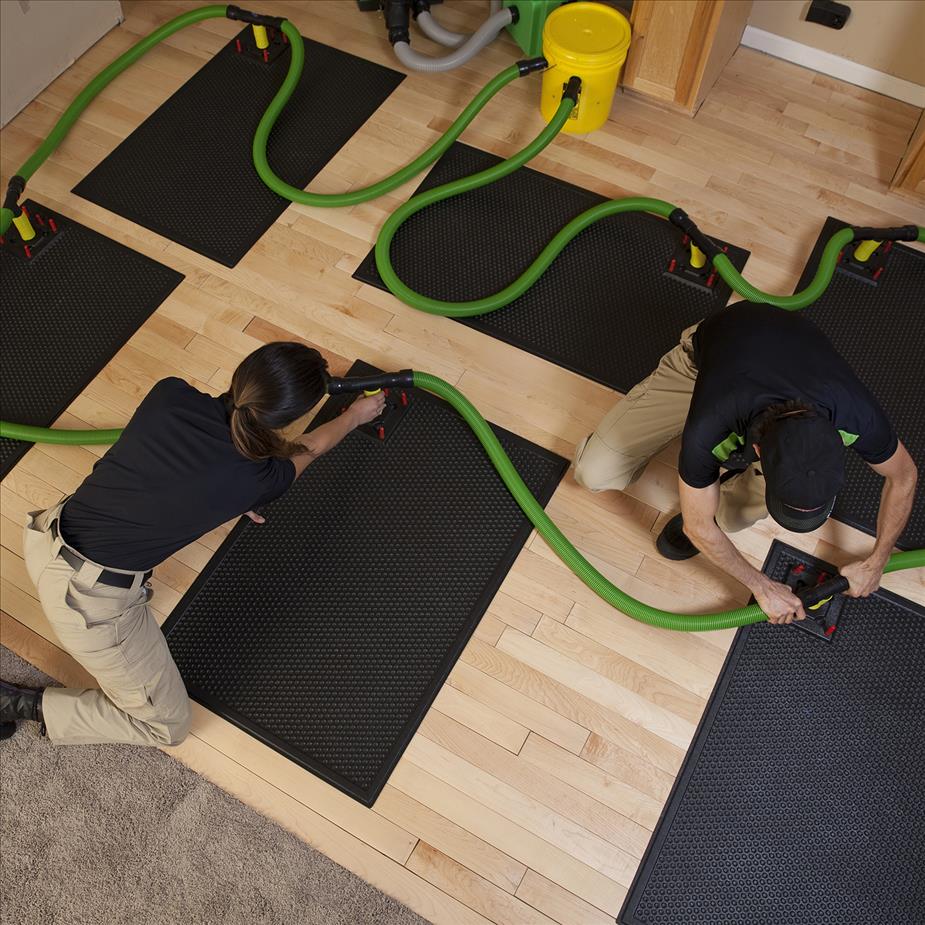 Smoke and Soot Damage Can Cause a Pervasive Odor in Your Berwyn Home.
Smoke and Soot Damage Can Cause a Pervasive Odor in Your Berwyn Home.
Smoke and soot is very invasive and can penetrate various cavities within your home, causing hidden damage and odor. Our smoke damage expertise and experience allows us to inspect and accurately assess the extent of the damage to develop a comprehensive plan of action.
Smoke and soot facts:
- Hot smoke migrates to cooler areas and upper levels of a structure.
- Smoke flows around plumbing systems, seeping through the holes used by pipes to go from floor to floor.
- The type of smoke may greatly affect the restoration process.
Different Types of Smoke
There are two different types of smoke–wet and dry. As a result, there are different types of soot residue after a fire. Before restoration begins, SERVPRO of La Grange Park/North Riverside will test the soot to determine which type of smoke damage occurred. The cleaning procedures will then be based on the information identified during pretesting. Here is some additional information:
Wet Smoke – Plastic and Rubber
- Low heat, smoldering, pungent odor, sticky, smeary. Smoke webs are more difficult to clean.
Dry Smoke – Paper and Wood
- Fast burning, high temperatures, heat rises therefore smoke rises.
Protein Fire Residue – Produced by evaporation of material rather than from a fire
- Virtually invisible, discolors paints and varnishes, extreme pungent odor.
Our Fire Damage Restoration Services
Since each smoke and fire damage situation is a little different, each one requires a unique solution tailored for the specific conditions. We have the equipment, expertise, and experience to restore your fire and smoke damage. We will also treat your family with empathy and respect and your property with care.
Have Questions about Fire, Smoke, or Soot Damage?
Call Us Today – (708) 240-4873
Podcast from the U.S. Fire Administration
8/23/2022 (Permalink)
Life is getting busier, the days are seemingly becoming shorter, and many Americans are struggling with time management. During times like these it may be more difficult to get your daily news. However, many are combating the concept of time with strategic planning and multitasking.
Many years ago during my studies as a marketer many marketing professionals noticed a decline in audio advertising. This decline had been made consistent and many advertisers began to look for other sources to market their products and services. Them the boom of Podcast begun. Podcast are extremely popular because of multiple reasons. The first being that podcast are readily available during anytime of the day.
No more struggling to get your daily fire prevention and safe new as The U.S Fire Administration releases its eight episode on https://www.usfa.fema.gov/podcasts/. The U.S. Fire Administration Podcasts are dedicated to getting the right message out to the folks on a time crunch. No more will you have have to struggle making it near a radio or television for important news on fire, emergency services and more. The U.S. Fire Administration Podcasts have audio as well as written versions of their podcast online and available at anytime. The podcast can be found at https://www.usfa.fema.gov/podcasts/ or on Apple Podcasts and Google Podcast apps and websites.
Celebration of the Fourth of July holiday and safety
7/1/2022 (Permalink)
As the 2022 Independence day weekend begins many Americans are setting up plans for barbeques / Cook outs, festivals and Fireworks.
Did you know that different states have different laws on the sales, operation and even possession f fireworks? Illinois has one of the more strict laws on fireworks as opposed to our neighboring states.
So here's what you need to know before planning your 4th of July firework show.
There is nothing like firing up the grill during the summer months! Did you know, July is the peak month for grill fires? A backyard barbecue can become dangerous quickly if proper safety precautions aren't considered. Your local SERVPRO franchise professionals want you to have an enjoyable and safe summer. Consider the following tips to help ensure your summer celebrations are disaster-free.
- Propane and charcoal barbecue grills should only be used outdoors.
- The grill should be placed well away from the home, deck railings, and out from under eaves and overhanging branches.
- Keep children and pets away from the grill area.
- Keep your grill clean by removing grease or fat buildup from the grill and in trays below the grill.
- Never leave your grill unattended.
- When using a charcoal grill, let the coals completely cool before disposing in a metal container.
- Anyone using fireworks or standing nearby should wear protective eyewear.
- Do not try to re-light or handle malfunctioning fireworks. Keep a bucket of water nearby to fully extinguish fireworks that don't go off or in case of fire. Children should never pick-up fireworks that may be left over as they may still be active.
The safest way to enjoy fireworks is to attend a public display conducted by trained professionals. If your residential or commercial property suffers from structural fire damage, call your local SERVPRO franchise professionals to help make it "Like it never even happened."
Open Fire Camping and Grilling Safety
3/30/2022 (Permalink)
As we step into spring and the days get longer the weather temperature begins to rise to melt away our winter wonderland. Melting snow and spring showers water blooming flowers. With temperatures heating up and the perfect conditions for outdoor gatherings and activities, the temptation to spark up an open flame and share stories becomes enticing. The smell of food on the grill, a nice warm breeze, and your favorite song create the perfect mixture for some good times at your home or favorite campsite. But with great grilling power comes great responsibility so here are some tips for controlling your open fire for the upcoming seasonal festivities.
The National Fire Protection Association reports that an average of 8,800 home fires are caused by grills and barbecues. One out of every seven residential fires involve a grill as the ignition source. Grilling statistics from NFPA states that between 2014-2018 on average 10,600 home fires are started by grills each year with almost 20,000 patients going to the ER from grill-related injuries. If you know anything about fires then you probably know Smokey Bear, a character in the longest-running public service announcement in the United States. Smokey Bear’s informational public website state” In the United States, nearly nine out of 10 wildfires are caused by people not being careful. These numbers could be shocking so we’ve gathered some information to keep you safe around the grill and campfire during these seasonal changes.
Let’s start off with some Campfire rules. The first step is finding somewhere that allows you to safely maintain a fire. Dig a pit and create a 10-foot radius down to the dirt, far from overhanging branches or anything that could catch fire. Circling the pit with rocks and stacking extra wood upwind away from the fire prevents the fire from spreading. When starting your fire be sure to have lots of water and dispose of the match used to start the fire into the fire. Remember, never leave a campfire unattended and never put anything but wood into the fire. When putting your fire outspread the pieces of fuel and dump a liberal amount of water on it, stir it with water, and add more water as needed. Once the water is cold to touch, you’ll be able to leave the site.
Some grilling tips that are good to have are similar to the campfire rules listed above. Propane and charcoal barbeque grills should only be used outdoors and away from your home, deck railings, and overhanging branches. Grills should be clear of any grease or fat build-up. Propane grills should be checked for hose leaks at least once before using each year. When starting charcoal grills be sure to only use charcoal starting fluid and never add fluid to an open fire. Grills should never be left unattended and when finished grilling, allow the coals to completely cool before disposing of them in a metal container. We hope these tips help you stay safe this upcoming season and remember for all your fire, water, and restoration needs call your local SERVPRO professionals
10 Safety Tips to Prevent a Dryer Fire
3/11/2022 (Permalink)
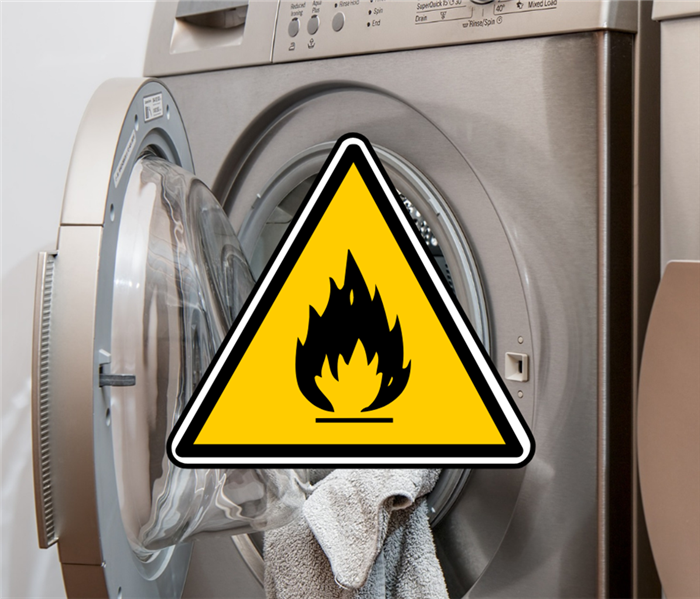 Consider running the dryer only when you are home and awake for your own safety.
Consider running the dryer only when you are home and awake for your own safety.
We usually wash and dry our clothes on a daily or weekly basis. However, it is critical to keep your clothes dryer in good working order in order to keep your home and family safe. Avoiding these specific bad habits can help you avoid a potentially disastrous house fire.
- Installation by a Professional
Professional technicians can ensure that your dryer is installed correctly and carefully. These professionals should be knowledgeable about a wide range of units, including gas and electric dryers, as well as washer/dryer combos. Most manufacturer recommendations, such as proper vent pipe installation, are familiar to these technicians.
A technician would explain how minimizing bends in the pipe is important because it creates fewer opportunities for lint to accumulate. They can install a dryer vent fan for you if the distance between the vent and your dryer is significant. This is an automatic electric device that increases airflow through the duct whenever the dryer is turned on. Having a professional install and service your dryer unit can help ensure that any potential hazards are handled correctly.
- Ongoing Maintenance
According to experts, the primary cause of clothes dryer fires is a failure to clean and maintain them. Check behind the dryer, where lint tends to accumulate. You should clean your dryer once a year and inspect the hose and vent for blockages twice a year.
It is a good idea to have a qualified service person clean the interior of the dryer chassis once a year. This will reduce the amount of lint that accumulates while also providing you with a professional opinion on the safety of your unit. In addition, a professional can inspect the venting and exhaust system. Employ only certified dryer exhaust technicians to ensure that this procedure is carried out correctly.
- Keep Flammables to a Minimum in the Surrounding Area
Dryer lint is not the only flammable that should be considered and kept away from the dryer unit's heat. Anything flammable should be swept up and disposed of before it accumulates and creates a fire hazard. Cleaning up dust and lint is time-consuming, but it is far less difficult than dealing with the aftermath of a fire.
On the same note, do not store cleaning products, boxes, or clothing baskets near the dryer because they may start a fire that spreads quickly. While this is an extreme case, keeping the area clutter-free is an important step toward fire prevention.
- Remove and clean the lint filter before and after each load of laundry.
Household dust and lint are the most common sources of ignition in dryer fires. They congregate within the dryer cavity, which is located near the heating elements. Temperatures can reach 550° here, which is hot enough to start a fire. It is never a good idea to forget to clean out your lint filter.
Cleaning the lint screen before and after each drying cycle is a good habit to get into during your laundry routine. This is an obvious first line of defense in the prevention of dryer fires. Wiping down the interior of the dryer will also remove excess lint buildup that the screen does not catch. This is a less obvious step that many people overlook, but it is nonetheless critical.
It is also critical that you never use a dryer without a lint filter, as this removes the dryer's built-in defense against hazardous lint buildup. This may seem obvious, but you'd be surprised how frequently it occurs.
- Only use metal venting material that is rigid or flexible
Most clothes dryer manufacturers recommend using flexible or rigid metal venting material to maintain proper drying time and airflow. Lint can accumulate in accordion-style ductwork, causing clogs and increasing blockages. Any dryer venting made of plastic or coiled wire foil should be replaced immediately with rigid non-ribbed metal ducts. Purchasing from a reputable vendor is critical to ensuring that your unit meets the necessary safety standards.
It is always a good idea to do your research on any major appliance before purchasing it. Looking at the unit's website to ensure it is from a reliable source, as well as researching customer reviews, can help you make an informed decision.
- Ensure that the air exhaust vent pipe is not obstructed
One of the leading causes of dryer fires is clogged dryer vents. When the vents are clogged, it is difficult to tell. Some people are completely unaware that the vents must be cleaned on a regular basis. However, it is critical to understand that lint accumulates on a large scale within the hoses and, when combined, can cause a serious problem. The accumulation restricts airflow, which can lead to overheating and fire.
In between professional inspections, clean the outside exhaust vent regularly. It is best to check this when your dryer is running by making sure that the exhaust air is escaping properly. If you cannot feel any air, it is likely that there is a lint accumulation clogging the vent outlet. This might require you to disconnect the exhaust vent from the dryer to remove the clog. Remember to reconnect the ducting to the outside vent and dryer before you use the dryer again. If you are unsure of how to do this, it is always recommended that you contact the manufacturer for help or hire a professional.
- Avoid Overloading
Laundry is easy to put off, especially if you have a busy schedule. However, this can lead to you saving all of your dirty laundry to be cleaned on the same day, and it's easy to use this as an excuse to overload your dryer, which can be dangerous.
A heavy load is too much for the dryer and is the most common reason for it to break down. Aside from downtime and repair costs, an overloaded dryer can cause the drum belt, spindle bearings, and pulleys to work overtime, resulting in higher-than-normal temperatures. When this occurs, the friction can ignite a spark, resulting in a fire.
This may be the most straightforward cause of dryer fires and malfunctions to avoid. Maintain organization by limiting your laundry loads to a few times per week. If your schedule makes this difficult or unreasonable, it may be better to simply split your laundry load into two or three loads instead, and take a slightly longer (albeit safer) time to complete this necessary chore.
- Examine Gas Lines
Qualified professionals should inspect the gas line and connection to ensure that they are leak-free and in good working order. Aside from a dryer fire, gas leaks are extremely dangerous and can cause a variety of problems. If you notice a burning odor when using your dryer, stop using it immediately and contact the manufacturer as soon as possible. At all times, stay away from the suspected gas leak area.
- Use the Proper Plug and Outlet
Dryer grounding is critical to their proper operation. Check that you are using the correct electrical plug and outlet as specified by the manufacturer. A licensed professional installing your dryer unit is a good way to ensure that you are doing this.
Check all connections on a regular basis and keep an eye out for any changes. If anything appears to be wrong, loose, or discolored, stop using it right away. Overloaded electrical sockets frequently cause tripped circuit breakers or blown fuses, which can result in a house fire.
- Never use the dryer when you are leaving the house or sleeping.
We've all succumbed to convenience and thrown a load of laundry in the dryer before heading to work or running errands. However, if a fire starts while you are away, you will be unable to put it out. Furthermore, if you are sleeping, it may be too late for you to realize that your house has caught fire.
Consider running the dryer only when you are home and awake for your own safety. It's also a good idea to keep a fire extinguisher in your laundry room in case anything goes wrong.
The Fire Hazards of Winter!
12/30/2021 (Permalink)
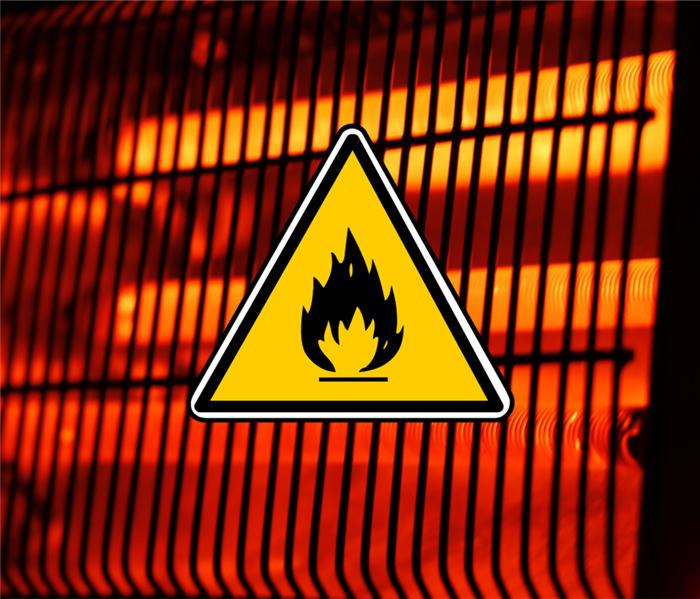 Anything that can burn should be kept at least three feet away from heating equipment!!
Anything that can burn should be kept at least three feet away from heating equipment!!
Keeping ourselves and our houses warm during winter can rapidly turn into a fire hazard, whether it's with a space heater, candles, or an electric blanket. There are various things you can do to make your home more fire-safe, as well as activities you can personally adopt to assist you to stay safe this winter.
Candles
- Candles should be kept at least 3 feet away from anything that can catch fire.
- Place candles in robust holders and in places where they won't be easily knocked over.
- Make sure that candles are out of reach of youngsters and dogs.
- If you leave the room, fall asleep, or go to bed, extinguish all candles.
Electrical equipment/appliances
- Only use one wall outlet at a time to plug in a heat-producing gadget (coffee maker, space heater, microwave, etc.).
- When using a heat-producing appliance, never utilize an extension cord.
- Extension cords should only be used for a short period of time.
- Furniture, beds, curtains, clothing, and flammable or combustible gases and liquids should all be kept away from lamps, light fixtures, and light bulbs.
Heaters
- Make room for space heaters! Anything that can burn should be kept at least three feet away from heating equipment (furnace, fireplace, wood stove, portable heater, etc.).
- When you leave the room or go to bed, turn off the space heater.
- A competent specialist should clean and inspect your heating equipment and chimneys once a year.
- Never heat your home using an oven.
Always make sure you have a working smoke and carbon monoxide alarm at all times in case of a fire.
Safety Tips for Deep Frying a Thanksgiving Turkey
11/3/2021 (Permalink)
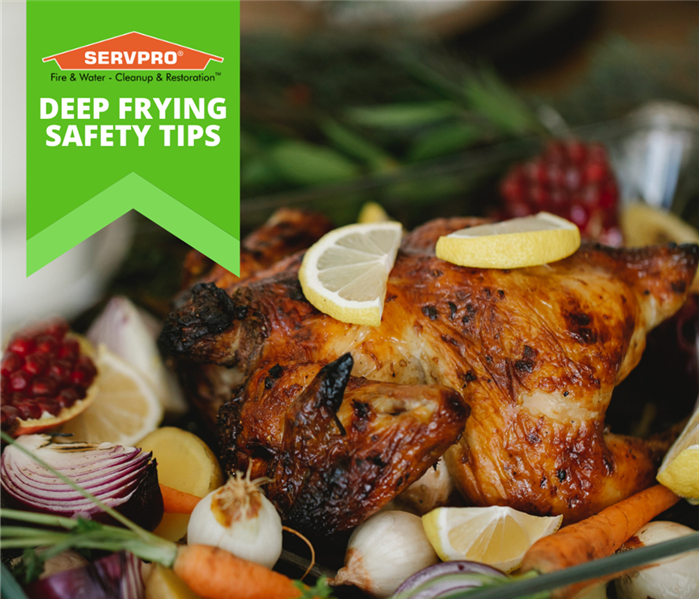 Safety tips to protect yourself, your loved ones, and your home!
Safety tips to protect yourself, your loved ones, and your home!
It’s November, so it’s time for turkey!!!
Deep frying is the newest trend in Thanksgiving turkey preparation. The outcomes can be wonderful, but the process can be risky. I will explain why deep-frying is dangerous and share safety tips to protect yourself, your loved ones, and your home.
Why deep fryers can be dangerous
- The fryer has the potential to tip over and spill gallons of heated oil.
- When the turkey is placed into the cooking pot, overfilling the pot with oil produces leakage. If the oil spills onto the burner, the entire fryer will burst into flames.
- When frozen or partially frozen turkeys are placed in the fryer, steam quickly expands, causing the oil to boil over.
- If there are no thermostat controls, the fryer units have the potential to overheat to the point of combustion.
- The sides of the cooking pot, the lid, and the pot handles can become extremely hot, resulting in severe burns.
Deep-Fried Turkey Safety Tips
- Place the turkey fryer at least 10 feet away from your home and away from children and pets. It should never be left unattended.
- Place the fryer on a leveled, flat surface and carefully measure out the amount of oil required.
- Make sure your turkey is totally thawed and dry before cooking.
- Keep an eye on the temperature of the oil and use the fryer with caution. Severe burns from the lid and handle are possible.
- Always keep a fire extinguisher or multipurpose dry powder on hand in case oil catches fire.
Thanksgiving Safety Tips and Fire Facts
11/2/2021 (Permalink)
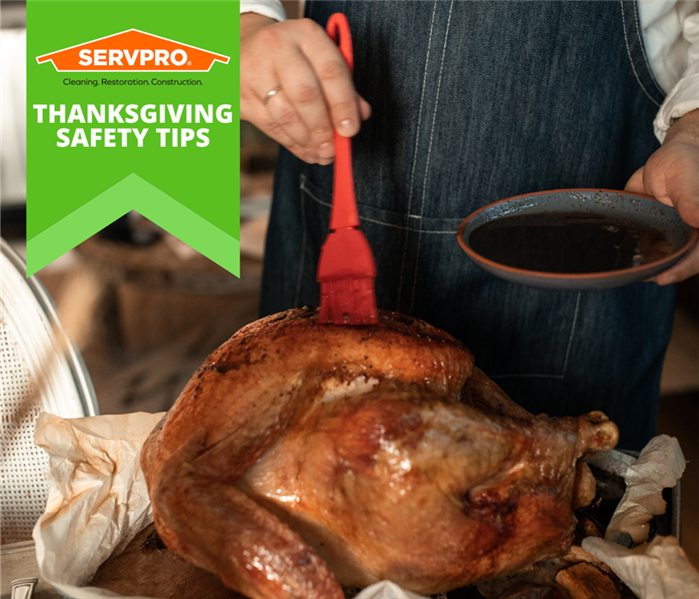 Thanksgiving Safety Tips and Fire Facts
Thanksgiving Safety Tips and Fire Facts
The kitchen is the heart of the home for most people, especially around the holidays. Everyone appreciates being a part of the preparations, from testing family recipes to creating cakes and pastries.
When there's a lot of activity and people at home, it's crucial to keep fire safety top of mind in the kitchen during this festive but chaotic time. As you begin to plan your holiday schedule and prepare a large family meal, keep in mind that by following a few easy safety tips, you can spend time with your loved ones while also keeping yourself and your family safe from fire.
Safety Tips
- While you're cooking, stay in the kitchen to keep an eye on the food.
- The stove will be very hot, so children should keep at least three feet away.
- Keep children away from hot foods and beverages. Vegetables, gravy, or coffee steam or splashes can cause significant burns.
- Make sure that no electric wires from a coffee maker, plate warmer, or mixer are dangling off the counter or within easy reach of a child.
- Matches and utility lighters should be kept out of reach of children, preferably in a locked cabinet.
- Never leave a lit candle alone in a room unattended.
- Check to see if your smoke detectors are working. By using the test button, you can put them to the test.
Thanksgiving Fire Facts
- Thanksgiving Day, the day before Thanksgiving, Easter, and Christmas Eve are the most common days for home cooking fires.
- On Thanksgiving Day in 2018, U.S. fire agencies responded to an estimated 1,630 home cooking fires, the busiest day for such disasters.
- Cooking that was left unattended was by far the most common cause of cooking fires and fire deaths.
Fire Safety Tips for Your Pets
7/12/2021 (Permalink)
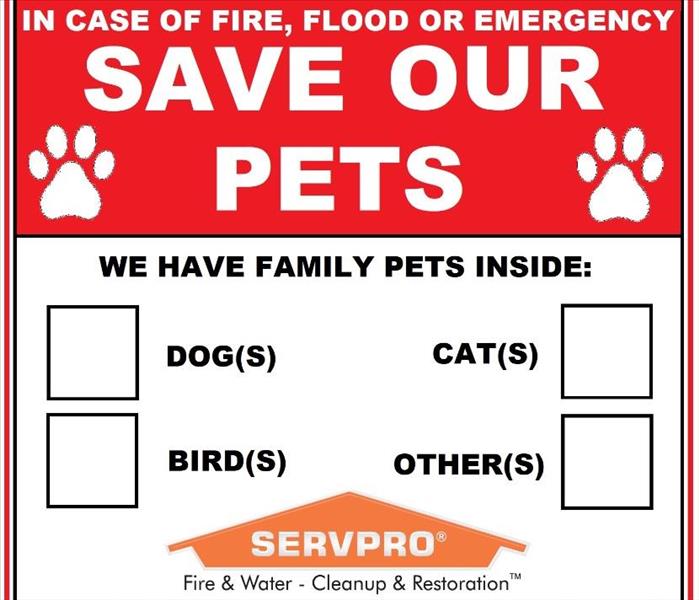 Take action before an emergency takes place!
Take action before an emergency takes place!
An emergency can happen at any moment, and you may never be able to fully prevent such events. However, you can prepare yourself and pets for when emergencies do take place. Here is a list of tips that will help your furry friends when a fire takes place.
- Consider installing monitored smoke detectors! If you live in a fire-prone area, monitored smoke detectors are always a smart choice. This will help the firefighters get a notification, and can respond as quickly as possible. Even if you are not home.
- Make sure to take note where your pets like to nap or hide. This is very important in event that needs evacuation in your home quickly. Remember that pets can be exponentially more difficult to round up if they sense stress. (Especially cats!) Practice crating your pets in advance to make it a positive experience. This will then help prevent them from running when you pull out their crate during any type of emergency.
- You need to have an emergency plan, and practice escape routes with your pet. Make sure to include all members of the family in this plan. Also make sure they know what to do and where to go.
- Have the phone number and address your local animal hospital handy. If your pet is injured, you will need to know where to take them for help ass quickly as possible.
- Make sure to pet-proof your home. Ensure there are no areas where pets can start fires accidentally. This includes stove knobs, loose wires, candles, fireplaces and other potential hazards in your home. Never leave a pet unattended with a lit candle or fireplace.
- If you have to evacuate, make sure to take your pets with you whenever possible. If you leave them behind, they may become trapped or escape and then be exposed to numerous life threatening hazards. In advance, make sure to contact your veterinarian for a list of preferred boarding kennels and facilities. Also, ask your local animal shelter if they provide emergency shelter or foster care for pets. Identify hotels and motels that accept pets, and also ask friends and relatives in your area if they would be willing to take your pet in case of an emergency.
- Get a rescue alert sticker! This easy to use sticker will let firefighters know that there are pets inside your home. Make sure it is visible, and we recommend placing it on or near your front door. This sign will include the types and number of pets in your home.
We here at SERVPRO have teamed up with local fire departments and animal hospitals to provide people with these stickers!
Summer BBQ Grilling Safety Tips
7/8/2021 (Permalink)
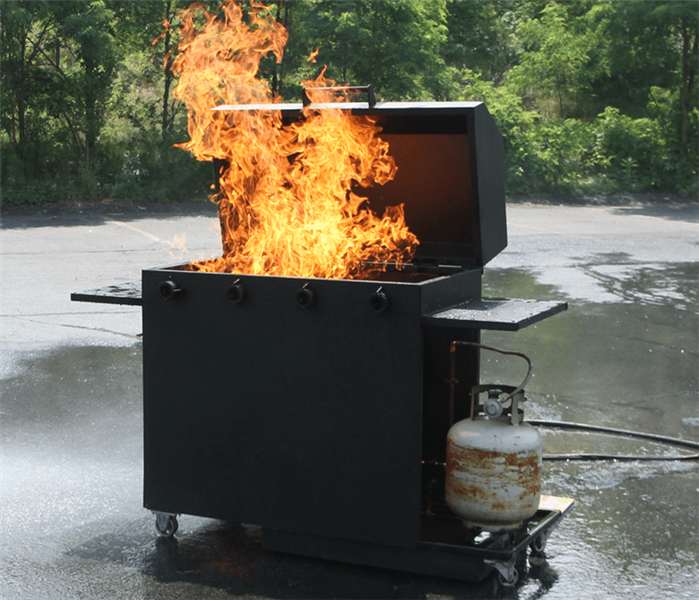 Fire safety for summer BBQ's!
Fire safety for summer BBQ's!
Grilling outside on a hot summer day is one of the most popular cooking methods in the summer. However, each year in the U.S. there are 10,200 home fires that are caused by outdoor grills. According to the National Fire Protection Association, July is the peak month for grill fires. Grill fires can start easily and spread quickly when the gas or charcoal is placed too close to any fire hazards. Here are 9 grilling safety tips for your summer BBQ's.
1. Only use grills outside
You might think it is okay to grill inside of your open garage or under a covered balcony, but propane and gas, charcoal grills are strictly designed for outdoor use where there is plenty of ventilation. If there is any combustible materials that surround or hang over the grill, it can catch fire easily and quickly. Make sure that the area over top and around the grill is clear.
2. Place your grill away from your home
BBQ grills are often placed just outside the back door or on the back deck. You should avoid placing your grill in these areas because it can pose a potential fire hazard. Grills that are placed too close to the house or wood structures can heat up adjacent materials and cause a fire to start. You want to make sure you keep at least 10 feet from your home or other structures.
3. Make sure your grill is located on a flat and level surface
If you place your grill on a slope or other uneven surfaces, it can tip over easily and cause a fire. Make sure that your grill is et up on a stable surface such as a concrete pad so it remains level while in use.
4. Check your grill for leaks
If you store your grill inside during the winter, make sure to check it over thoroughly when grilling season in the summer begins. A leak in the gas lines can cause propane or natural gas to build up inside when the lid is closed. Check the gas lines to make sure that they are free of leaks before using the grill. Make sure you also always open the lid of your grill before lighting.
5. Always clean your grill after use
When you BBQ regularly, it causes grease to build-up on the grill plates and collect inside the grease tray. If it is not cleaned, the build-up can then act as fuel and catch fire while the grill is in use. Clean your charcoal or gas grill after each use with a grill brush and empty the grease tray when it begins to fill up.
6. Never leave your brill unattended while in use
Never leave the grill unattended while you are cooking food. Grills use high heat and open flames to cook food, and when left unattended can become a safety and fire hazard. If you have to leave the grill, ask another adult to watch the grill for you.
7. Wear appropriate clothing
Clothing that has long sleeves or pieces that dangle can catch fire easily when too close to an open flame. When grilling food, wear clothing that won't interfere with the cooking process. Also, make sure that any apron strings are tied back away from the front. If a piece of clothing does catch fire, remember to stop, drop, and roll to extinguish the flames quickly.
8. Keep a spray bottle on hand
It is common for grills to flare up as fat drips from meat as it is cooking. This can cause a section of the grill to remain on fire as it burns away. If left alone, the flames will continue to burn and cause excess smoke to billow out from under the lid. Make sure you keep a spray bottle filled with water beside your grill so that you can quickly extinguish smaller flames before they begin to spread.
9. Always have a fire extinguisher close by
If a fire where to break out, follow these tips on how to put out a grill fire and ensure you have First Alert EZ Fire Spray within reach. It is simple to use, just point and spray to extinguish the fire. The spray is also quick and easy to clean up after use. It's small, compact size makes it the perfect addition to your grilling set to help keep your loved ones safe.
Following these safety tips and having the right protection will help you and your family enjoy a safe grilling season this summer!
Smoking in the home
3/12/2021 (Permalink)
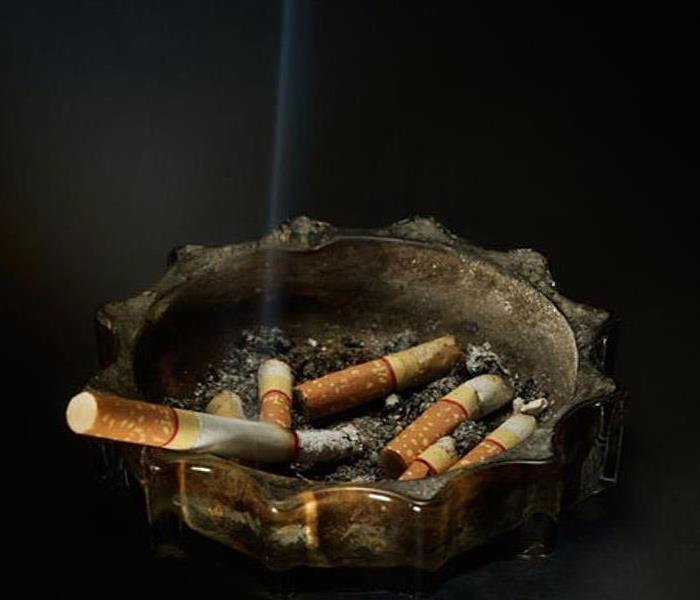 Emergency Service Response 24/7
Emergency Service Response 24/7
According to the National Fire Protection Association, smoking materials that include cigarettes, pipes, and cigars started an estimated 17,200 home structure fires. This was reported from U.S. fire departments. Amongst these 17,200 estimated fires, these fires cause 570 deaths, 1,140 injuries and $426 million in direct property damage. It was also reported that smoking materials caused 5% of reported home fires, 21% of home fire deaths, 10% of home fire injuries, and 6% of the direct property damage. According to the NFPA, most deaths in home smoking-material fires were caused by fires that started in bedrooms or in living rooms, family rooms or dens. It is also a face that the risk of dying in a home structure fire caused by smoking materials rises with age.
With that being said, it is encouraged to use smoking materials outside of the home. Designate a "smoking area" such as the garage or outside. This will help eliminate the risk of a fire starting in the actually home.
Lending a helping hand
1/5/2021 (Permalink)
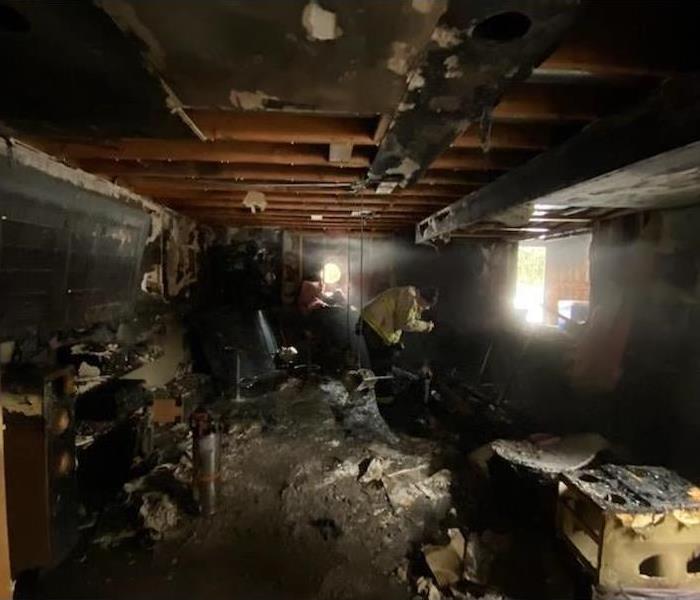 Residential Fire Damage
Residential Fire Damage
We have a really great relationship with our local fire departments, and follow their social media pages. After scrolling through our daily feed, we came across the Addison Fire Department's post about a local fire. What stood out about this post was that our local fire department and other FDs went to help with this major residential fire that took place. The AFPD responded to a house fire, and the smoke detectors did their job by alerting the family of the fire. They were all able to escape safely. They were very thankful for the help from the Wood Dale FPD, Elmhurst FD, and Itasca FPD for coming out to help. The family had told the firefighters that there were two guinea pigs in the home, and they were able to find and save them. The guinea pigs received O2 therapy and vigorous rubbing, and both where successfully resuscitated. The fire started in the basement, and the heat and smoke rose up throughout the house. They enforced to make sure your smoke detectors are working, and the batteries are changed! They also stated to make sure you keep your bedroom doors closed when sleeping, and try not to risk your life to save a pet. That is what the firefighters are for, and they will do their best to rescue them.
The main take away from this message was to always make sure to test your smoke detectors at least once a month, and the batteries should be replaced at least once or twice a year. Also, a huge shoutout to our local fire department for helping out a different fire department in order to get everyone out safely, along with the pets.
After fire cleanup
11/3/2020 (Permalink)
After fire cleanup
Smoke and soot is very invasive and can penetrate various cavities within your home, causing hidden damage and odor. Our smoke damage expertise and experience allows us to inspect and accurately assess the extent of the damage to develop a comprehensive plan of action.
Smoke and soot facts:
- Hot smoke migrates to cooler areas and upper levels of a structure.
- Smoke flows around plumbing systems, seeping through the holes used by pipes to go from floor to floor.
- The type of smoke may greatly affect the restoration process.
Different Types of Smoke
There are two different types of smoke–wet and dry. As a result, there are different types of soot residue after a fire. Before restoration begins, SERVPRO of LaGrange Park/North Riverside will test the soot to determine which type of smoke damage occurred. The cleaning procedures will then be based on the information identified during pretesting. Here is some additional information:
Wet Smoke – Plastic and Rubber
- Low heat, smoldering, pungent odor, sticky, smeary. Smoke webs are more difficult to clean.
Dry Smoke – Paper and Wood
- Fast burning, high temperatures, heat rises therefore smoke rises.
Protein Fire Residue – Produced by evaporation of material rather than from a fire
- Virtually invisible, discolors paints and varnishes, extreme pungent odor.
Our Fire Damage Restoration Services
Since each smoke and fire damage situation is a little different, each one requires a unique solution tailored for the specific conditions. We have the equipment, expertise, and experience to restore your fire and smoke damage. We will also treat your family with empathy and respect and your property with care.
Have Questions about Fire, Smoke, or Soot Damage?
Call Us Today – 708-240-4873.
Safety tips for the upcoming holidays
11/2/2020 (Permalink)
Per the National Fire Protection Association, nearly 47,000 fires occur during the winter holidays claiming more than 500 lives, causing more than 2,200 injuries, and costing $554 million in property damage. The National Fire Protection Association also states that on average, one of every 22 home fires started by Christmas trees result in death.
www.redcross.org/homefires, has several good home safety tips for the holidays to keep your home safe. We at SERVPRO LaGrange Park/North Riverside wanted to share some of those tips with you to ensure a safe holiday season.
- Place Christmas trees, candles, and other holiday decorations at least three feet away from heat sources like fireplaces, portable heaters, radiators, heat vents and candles.
- Purchase flame retardant metallic or artificial trees. If you purchase a real tree, make sure that it has fresh, green needles that aren’t easily broken. Keep live trees as moist as possible by giving them plenty of water.
- Make sure that light strings and other holiday decorations are in good condition. Do not use anything with frayed electrical cords and always follow the manufacturer’s instructions.
- Always unplug tree and holiday lights before leaving home or going to bed.
- Never use lit candles to decorate a tree. Always extinguish candles before leaving the room orgoing to bed.
- Use only sturdy tree stands designed not to tip over. Keep curious pets and children away from Christmas trees.
- Keep anything that can catch on fire—pot holders, oven mitts, wooden utensils, paper or plastic bags, food packaging, and towels or curtains—away from your stove top.
- Designate one person to walk around your home to make sure that all candles and smoking materials are properly extinguished after guests leave.
The following video also shares other great ideas to keep in mind this holiday season.
Holiday Fire Safety
Have a safe and wonderful holiday season from your friends at SERVPRO LaGrange Park/North Riverside
Carbon monoxide the silent killer
7/23/2020 (Permalink)
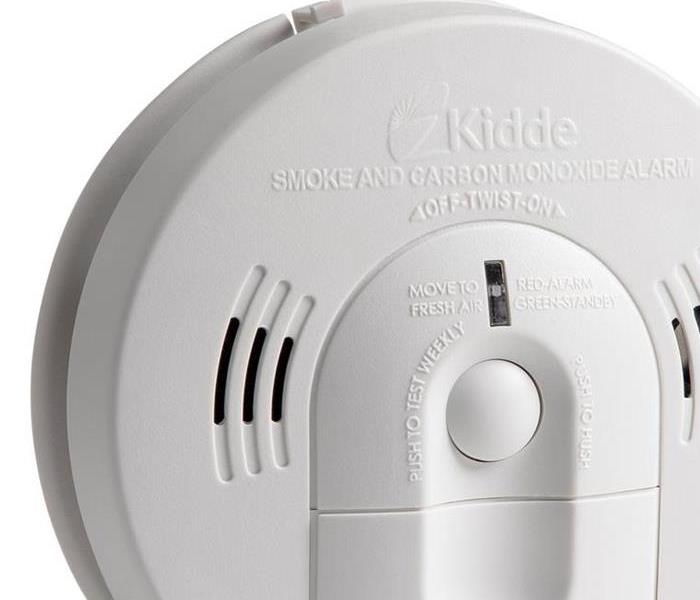 Make sure to get yours today!
Make sure to get yours today!
Did you know that local fire departments require carbon monoxide detectors?
The Elmhurst Fire Department requires that each home be outfitted with carbon monoxide detectors, in addition to smoke detectors.
For some people, they may not know this, so here are some helpful tips and steps about the carbon monoxide detector.
First off, Carbon monoxide is a colorless, odorless, and tasteless gas that is poisonous to humans. It is known as the "silent killer" because humans cannot tell when they are around it. The carbon monoxide detector is a safety device that can alert homeowners of a CO leak, and then help them escape a potentially life-threatening situation.
Carbon monoxide can be produced by any fuel-burning device. There are three main sources, and they are your home's furnace, dryer vent in a drying machine, and fireplace or chimney. It is VERY IMPORTANT to have those sources regularly services and cleaned by a professional to help prevent a CO leak.
When it comes to installation of the alarms, it is important to have them on every level of the home. That way all family members can hear the detectors go off. There should also be detectors in every bedroom, sleeping area, and common room for extra safety while asleep. They can be placed anywhere in the room, and can also be placed on the wall or the ceiling and will be just as effective.
Lastly, it is important to test your alarms regularly, so at least once a month. If it has replaceable batteries, they should be changed at least every 6 months. However, just because you replace the batteries doesn't mean they last forever. They have a lifetime of anywhere between 5-7 years.
The most common causes of house fires
7/23/2020 (Permalink)
There are many common causes when it comes to house fires, but there are measures that can be taken in order to avoid them.
Cook equipment that includes pots and pans can overheat very quickly, and they can cause a fire very easily if the person cooking gets distracted and then leaves the cooking unattended. ALWAYS stay in the area where cooking is taking place, or ask someone to water the food when cooking with hotplates.
Portable heaters are another common cause of house fire. Make sure to keep them at least one meter away from anything that could easily catch fire. This would include furniture, curtains, laundry, clothes and even yourself. If you have a furnace, get it inspected once a year to make sure it is working to safety standards.
Make sure to keep bedrooms off limits when it comes to smoking in the home. A cigarette tat is not put out properly can cause a flame, as the butt may stay alit for a few hours once one is done with it. It could burst into flames if it came into contact with flammable materials, such as furniture.
An electrical appliance, such as a toaster can start a fire if it is faulty or has a frayed cord. A power point that is overloaded with double adapter plugs can cause a fire from an overuse of electricity. Also, a power point extension cord can be a fire hazard if not used appropriately. Make sure to double check the appliances and power points in the home.
Candles may look and smell pretty, but if left unattended they can cause a room to easily burst into flames. Make sure to keep candles away from any obviously flammable items such as books and tissue boxes. Always blow out the candle(s) before leaving the room they are in.
Children can cause a fire out of curiosity, to see what would happen if they set fire to an object. Please make sure to keep any matchers or lighters out of reach in order to avoid this. Install a smoke alarm in your child's room and practice a home escape plan with your children and family in case there was a fire.
Homes with inadequate wiring can cause fires from electrical hazards. Some signs to see if you have bad wiring are
-lights dim if you use another appliance
-for an appliance to work, you have to disconnect another
-fuses blow or trip the circuit frequently
Make sure to have a licensed electrician come and inspect your home, or contact your landlord if you have any of the above occurrences.
Make sure when you barbeque to keep it away from the home, tablecloths or any plants and tree branches. Keep them regularly maintained and cleaned with soapy water and clean any removable parts. Check the gas bottle for any leaks before you use it each time.
If you have any flammable liquids in the home or garage such as petrol, kerosene or methylated spirits, keep them away from heat sources and check the label before story. Be careful when pouring these liquids.
Lastly, lamp shades and light fittings can build up heat if they are very close to light globes. Check around the house to make sure. Lamp bases can become a hazard if they are able to be knocked over easily, and so should be removed if they are. Check that down lights are insulated from wood paneling or ceiling timbers.
Prevent Cigarette Fires Inside and Out
2/25/2020 (Permalink)
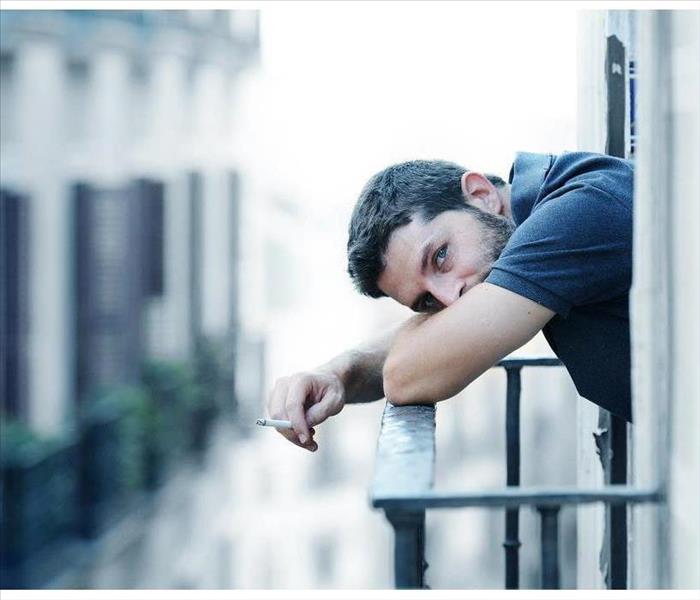 Always smoke outside to diminish the risk of a house fire
Always smoke outside to diminish the risk of a house fire
How Can You Reduce The Risk Of a Cigarette Fire?
The number of cigarette smokers in the U.S. is significantly lower than a few years ago, yet cigarettes are still a leading cause of home fires. The embers of a cigarette can burn hotter than the flame of your lighter or match. Caution should always be taken when smoking, especially indoors or around flammable materials outside. Even an ashtray fire can quickly turn into a disaster if not properly supervised. So, how can you reduce the risk of a cigarette fire?
1. Don’t Smoke in Bed
The sheets and blankets on a bed can brush the cigarette and catch fire or the ashes can fall in between the folds, igniting a fire. There’s the added risk that you’ll drift off to sleep before the cigarette has burnt out completely.
2. Practice Caution Indoors
Always smoke outside to diminish the risk of a house fire. Caution should be taken outside as well, though. Try to smoke away from anything flammable; dead leaves and pine needles are extremely flammable. It’s best to stay on a patio or driveway. Never throw a lit cigarette or cigarette butt on the ground.
3. Be Mindful of a Breeze
Whether indoors or out, a breeze can carry an ember away, sparking whatever it comes in contact with. A cigarette fire can get out of control before you even notice it.
4. Don’t Smoke Around an Oxygen Machine
Smoking around pure oxygen is a serious hazard, even if the oxygen machine is turned off. Since fire requires oxygen to burn, pure oxygen allows it to burn even hotter and faster than normal.
If you are a smoker, manage your cigarette closely and make sure it’s properly extinguished. Also, be sure to keep your smoke detectors maintained. If your La Grange, IL, home sustains damage from a cigarette fire, you can count on fire cleanup professionals. They’ll return your home to its preloss condition.
How To Prevent a Candle Fire
11/22/2019 (Permalink)
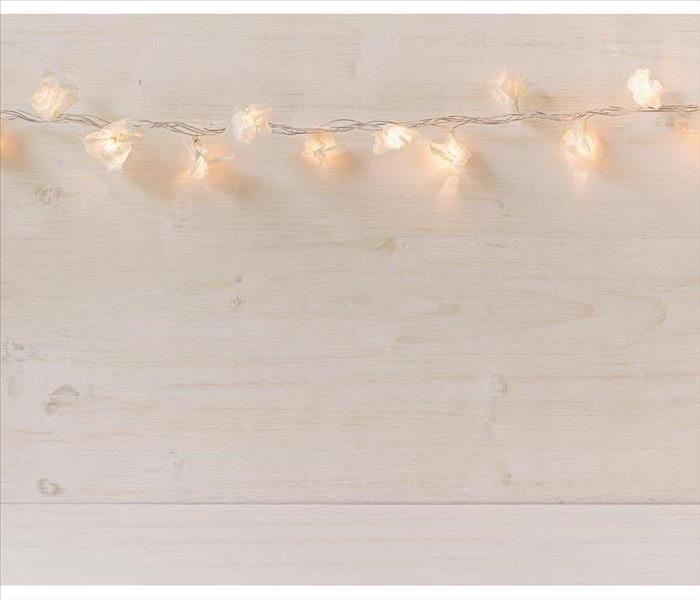 Fairy lights a candle substitute you can use
Fairy lights a candle substitute you can use
How To Prevent a Candle Fire
You might be comforted by the scent of a candle burning in your living room, but this object poses a serious risk to your home in La Grange Park, IL. Candle fires unfortunately happen often and usually because of negligence on the part of building occupants. If you wish to keep a candle in your home, there are ways to do so safely. These guidelines can help you enjoy the scent and warmth of a candle in your home while reducing the risk of a candle fire.
Use Alternatives
Fortunately, there are many candle alternatives that you can place in your home. These options let you enjoy the same effects of a regular candle but aren’t hazardous in any way. Below are some examples of candle substitutes that you can use:
- Battery-powered/flameless candles
- LED string lights
- Lava lamps
- Fairy lights
If you prefer to fill your home with the scent of a regular candle, there are also options that are designed to mimic the smell you love. Wax warmers, air fresheners and potpourri can give off a similarly pleasant scent with no fire hazard.
Practice Basic Candle Safety
If you must burn a candle for any reason and candle alternatives won't suffice, it’s your responsibility to be cautious and use common sense. Always blow out candles before you go to bed and never leave a flame unattended. If you have small children, never leave them alone with a burning candle. Additionally, when you light a candle, always ensure that there are no objects located within a twelve-inch radius of the candle. Taking these steps can protect you against harm and significantly reduce the risk of fire.
A candle fire cannot be prevented in some cases, even when you do everything you can to keep your home protected from danger and use reliable candle alternatives. No matter what kind of fire damage you’re facing, calling emergency restoration services for a fire cleanup can help your home recover immediately.
COOKING FIRES
11/18/2019 (Permalink)
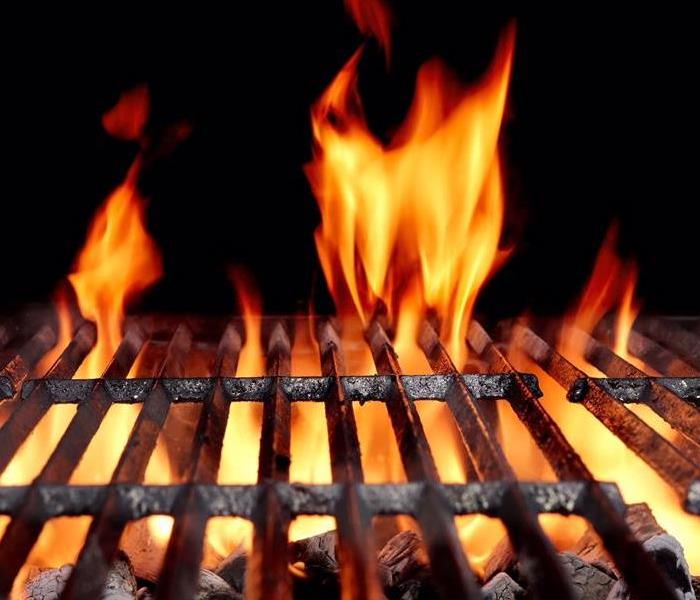 If the unthinkable happens and a fire strikes your business or home, give the experts at SERVPRO of La Grange Park/North Riverside a call.
If the unthinkable happens and a fire strikes your business or home, give the experts at SERVPRO of La Grange Park/North Riverside a call.
Did you know cooking equipment is the leading cause of residential fires?
As the holiday season begins and you find yourself in the kitchen more often while hosting friends and family, fire precautions should be top of mind.
A property owner experiences a flood of emotions when a fire ravages their business or home. Fear, uncertainty, stress, and doubt about the future
of the property and their livelihood can be overwhelming to the property owner long after the flames have been extinguished and the smoke has cleared.
After the first wave of heroes has rescued the property, let your the SERVPRO of La Grange Park/North Riverside professionals help you restore it to its preloss condition. Combining rapid response, the utmost professionalism, and open communication throughout the entire job process, we strive to restore not only the home or business structure but the customer’s peace of mind as well.
The National Fire Protection Association (NFPA) offers the following eye-opening statistics on structure fires.
*482,030 structure fires were reported in the United States in 2018.
*These fires caused $9.9 billion in property damages.
*One structure fire was reported every 48 seconds.
If the unthinkable happens and a fire strikes your business or home, give the experts at SERVPRO of La Grange Park/North Riverside a call. We will help make it “Like it never even happened.”
Does Lightning Cause House Fires?
10/9/2019 (Permalink)
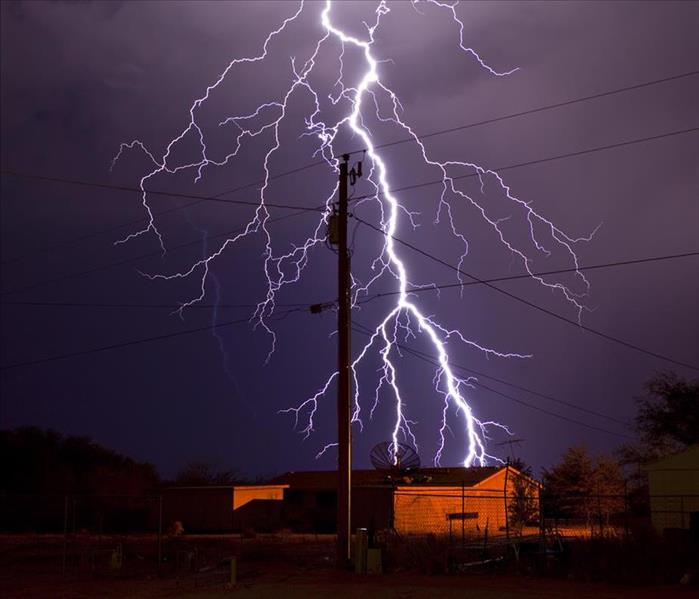 If a lightning fire strikes in your home, do your best to stay safe and get the help you need
If a lightning fire strikes in your home, do your best to stay safe and get the help you need
Severe storms in La Grange, IL can cause all kinds of trouble, including flooding, wind damage and even fire damage. There are precautions that can be taken to help prevent or minimize these types of damage, but due to the unpredictability factor of a lightning fire, you may do better to learn what should be done to stay safe in the event lightning strikes your home.
Things To Do Before and After a Strike
Because of the random nature of lightning, there are few preventive measures that can be taken to reduce the risk or the shock of a sudden lightning fire. There are a few things however that should be done immediately following a strike. Here are some guidelines for both.
Trim bushes and tree branches away from the house and roof to reduce the risk of a blaze spreading from foliage that may catch on fire
Have a lightning rod professionally installed to draw lighting safely away from the house
Turn off water, lights and other heavy draws on household electricity to reduce the attraction
Following a strike, the first priority is to make sure everyone gets out of the house
Once people are safely out, call 911 to get the fire department on its way, then alert next door neighbors so they can watch their homes
Don’t Go it Alone
A house fire is started by lightning over 22,000 times each year in the United States. Deaths or serious injuries and heavy property damage frequently accompany such a fire. If a strike does hit and start a blaze in your home, the first thing to do is to get out and call for help. Once the flames are out, it would be most helpful to call the fire and water restoration professionals in La Grange, IL to come and assist with fire damage cleanup. There may be a good deal of structural damage as lightning burns fast and hot, so get the help you need.
Take any preventive steps you can to prevent a disaster in an electrical storm. If a lightning fire strikes in your home, do your best to stay safe and get the help you need.
3 Common Causes of Home Fires
7/17/2019 (Permalink)
 Cigarettes are another common cause of house fires
Cigarettes are another common cause of house fires
Common Causes of Fires
Fires can devastate homes, and avoiding a home fire Riverside, IL, is often important to homeowners. However, many people aren't sure how to prevent fires in their homes. Learning about common causes of fires can be a helpful first step in preventing your home from sustaining fire damage.
1. Worn Electrical Cords
Many items in households today require electricity to function, which is one reason why electrical fires are common occurrences in residential areas. Over time, cords can become frayed, which can expose the wires and make a fire more likely to occur. It can be difficult to notice if cords that are not in view, such as cords to the television or other appliances, become frayed. In order to help to prevent this type of fire, it can be useful to check the wiring to all devices in appliances in your house and to replace frayed cords.
2. Kitchen Mishaps
There are several reasons fires in homes often begin in kitchens. Fires commonly start in kitchens when pots or pans are left unattended or when grease is left on a stovetop and catches fire. After kitchen fires, many homeowners find it useful to contact fire cleaning and restoration experts to restore their homes to their original states. Fortunately, you can often prevent a home fire by staying in the room while cooking and keeping your kitchen clean.
3. Smoking Inside
Cigarettes are another common cause of house fires, and this type of fire is more likely to occur when a person smokes inside their home. Many people unintentionally fall asleep while smoking on their beds or sofas, which often results in a fire. Improperly disposing of a cigarette in the home can also cause a fire. However, you can often prevent cigarette fires by smoking outside of your home and extinguishing cigarettes in an ashtray outside of your home as well.
Understanding common fire causes can help you to protect your home. Replacing worn electrical cords, using caution when cooking and not smoking inside can help you to prevent a home fire.
Creating a Fire Escape Plan for Your Office
6/25/2019 (Permalink)
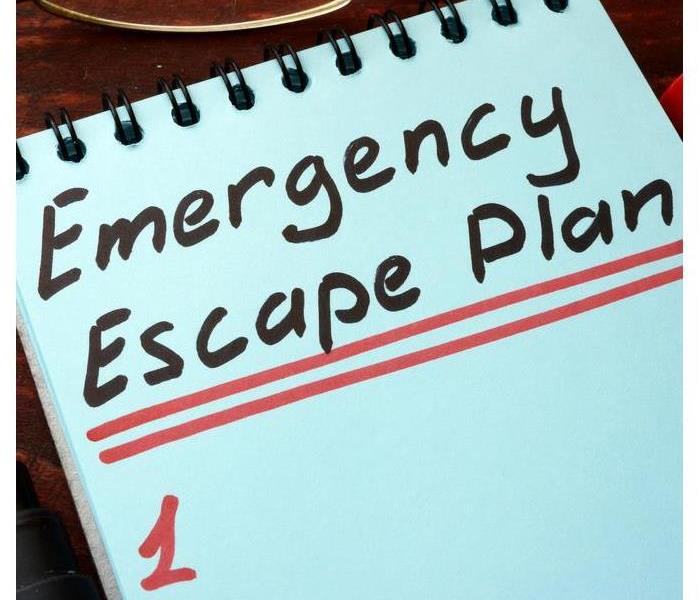 A fire evasion plan, also known as an emergency escape plan
A fire evasion plan, also known as an emergency escape plan
Imagine it’s a typical afternoon at your company in La Grange Park, IL. It’s business as usual, with your employees hard at work. Suddenly, the smoke alarm jolts everyone out of their normal routine, but when they see there’s a fire erupting in the hallway, they realize this is no ordinary fire drill. They have to leave immediately. A good fire escape plan, previously disclosed to and rehearsed with the staff, can ensure everyone exits the building safely during an emergency, and you can account for all employees.
What Is It and Why Is It Necessary?
A fire evasion plan, also known as an emergency escape plan because it is helpful for any emergency evacuation, is a strategy for exiting the building in the event of a fire. When creating such a plan, the best routes for evacuation are identified, so that everyone can leave the building safely and in a timely manner.
What Is Considered a Good Plan?
A good fire escape plan often includes the following:
- Designated managers who step into action in the event of an evacuation and make sure everyone exits the building safely and meets at the pre-planned meeting area
- Designated exits, depending on one's location in the building at the time of evacuation
- A meeting place for employees once they have exited the building
- A communication plan to use in the event of separation
- Time to practice the exit strategy once or twice a year so that employees are familiar with what to do in the event they have to evacuate
After the Fire Has Been Extinguished, What’s Next?
A fire is a most unwelcome tragedy, but it does not have to mean the end of business as you have known it. Companies specializing in emergency restoration services are Here to Help and can make the fire damage look “Like it never even happened.”
Hopefully, your business will never experience the misfortune of a fire. However, a good fire escape plan can ensure your employee's exit safely and give you additional peace of mind.
Eliminating Smoke Odor After a Fire
5/17/2019 (Permalink)
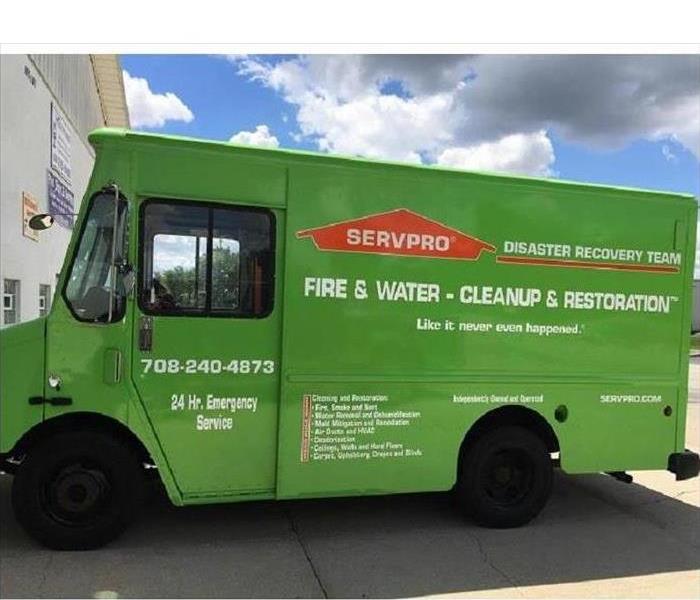 Call a fire restoration specialist in the Maywood, IL, area
Call a fire restoration specialist in the Maywood, IL, area
Smoke Cleaning Tricks to Remove the Stench From Your Home
While fires can be put out and some even mitigated with little restoration needed, smoke damage can linger. The smells associated with a fire can be challenging to remove, and it will often take a fair bit of elbow grease and possibly professional services to eliminate any residual odors thoroughly. However, there are a couple of smoke cleaning tricks you can use to remove the stench from your home.
1. Vinegar and Water
While the odor is only one aspect of smoke damage, it likely permeates from both hard and soft surfaces. Using a mixture of vinegar and water on all your homes hard surfaces can help. You will want to spray the walls, counters and shelves with this mixture and let it dry. Once dry, you can wipe everything down with a damp rag. Using the vinegar and water mixture should help to reduce the smoke smell.
2. Baking Soda
For porous surfaces, smoke cleaning with vinegar and water may not be the best option. Instead, use baking soda on carpets and other fabrics. The baking soda will absorb some of the odor-causing chemicals. After letting the baking soda sit on the porous materials for a while, you can use a vacuum to discard it. However, be sure to empty the vacuum afterward to avoid transferring any stink.
3. Professional Services
If neither of the above solutions help to remove the smoke odor from your home, or if they didn’t eliminate the odor altogether, then you can call a fire restoration specialist in the Maywood, IL, area. These professionals are experienced in fire damage and will be able to help you with your home’s deodorization.
Depending on the extent of the fire, DIY smoke cleaning may eliminate your home’s odor problems. However, in larger disasters or more significant blazes, a remediation expert may be necessary. In either situation, your home can return to normal with appropriate action.
EMERGENCY FIRE DAMAGE TIPS
2/12/2019 (Permalink)
 Don't waste time to plan to avoid a FIRE.
Don't waste time to plan to avoid a FIRE.
EMERGENCY FIRE DAMAGE TIPS
These emergency tips will assist you in taking proper action until your local SERVPRO® Franchise Professionals arrive. Follow these DOs and DON’Ts to help reduce damage and increase the chances of a successful restoration.
DO:
- Limit movement in the home to prevent soot particles from being embedded into carpet and avoid tracking.
- Keep hands clean. Soot on hands can further soil upholstery, walls and woodwork.
- If electricity is off, empty freezer and refrigerator completely and prop doors open to help prevent odor.
- Wipe soot from metal kitchen and bathroom faucets, trim and appliances.
- If heat is off during winter, pour RV antifreeze in sinks, toilet bowls, holding tanks and tubs to avoid freezing pipes and fixtures.
- Remove soot particles from plants with a damp cloth.
- Change HVAC filter, but leave system off until a trained professional can check the system.
- Tape double layers of cheesecloth over air registers to stop particles of soot from getting in or out of the HVAC system.
DON’T:
- Don’t attempt to wash any walls or painted surfaces without first contacting your SERVPRO® Franchise Professional.
- Don’t attempt to shampoo carpet, rugs or upholstered furniture without first consulting your SERVPRO® Franchise Professional.
- Don’t attempt to clean any electrical appliances (TV sets, radios, etc.) that may have been close to fire, heat or water without first consulting an authorized repair service.
- Don’t consume any food or beverages that may have
- been stored close to fire, heat or water. (They may be contaminated.)
- Don’t turn on ceiling fixtures if ceiling is wet. Wiring may be wet or damaged and cause electrical shock and air movement may create secondary damage.
- Don’t send garments to the dry cleaner. Improper cleaning may set in smoke odor.
P.A.S.S the acronym for portable fire extinguisher usage
2/12/2019 (Permalink)
 Making it "like it never even happened"
Making it "like it never even happened"
EMERGENCY FIRE DAMAGE TIPS
Portable fire extinguishers
Portable fire extinguishers can be life and property saving tools when used correctly. In order to operate an extinguisher, the National Fire Protection Association (NFPA) suggests remembering the word PASS:
Pull the pin. Hold the nozzle pointing away from you and release the locking mechanism.
Aim low. Point the extinguisher at the base of the fire.
Squeeze the lever slowly and evenly.
Sweep the nozzle from side-to-side.
Read the instructions on the fire extinguisher and become familiar with them before a fire breaks out. Remember, extinguishers do have limitations. It is also important to ensure you have the correct type of extinguisher for your facility. To find more information on choosing the appropriate class of extinguisher, please visit the NFPA website at nfpa.org.
Smoke Alarms: LIFE SAVERS
2/12/2019 (Permalink)
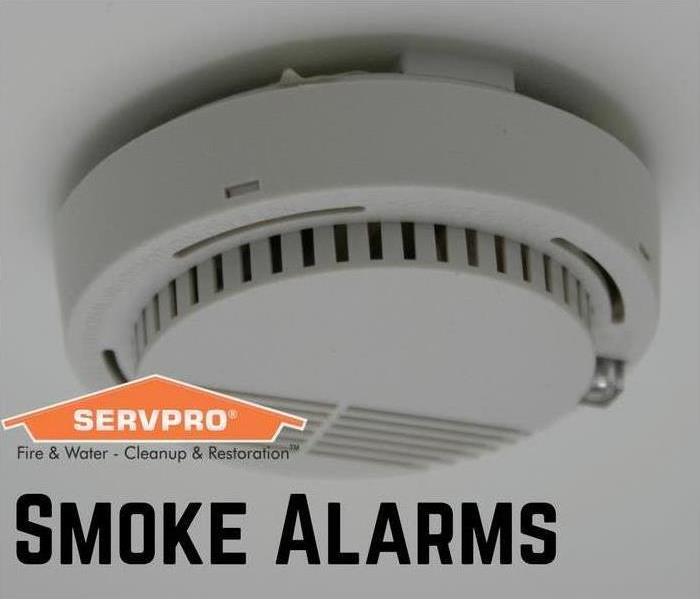 Don't let the batteries be the reason.
Don't let the batteries be the reason.
Smoke Alarms: LIFE SAVERS
Smoke alarms save lives when properly installed and maintained, according to the National Fire Protection Association (NFPA).
In homes, smoke alarms should be in every bedroom and on every level, including the basement. In office and commercial environments, check your state requirements or contact your local Fire Marshall to help ensure all codes are met.
Test smoke alarms monthly using the test button. Smoke alarms with non-replaceable batteries need the entire smoke alarm unit replaced every ten years. Other alarms need batteries replaced every year and the unit replaced every ten years. If the alarm chirps signaling low battery, take the proper steps to replace the unit or the batteries immediately. Never disable or remove the battery from an alarm. Almost half of fires where smoke alarms were present but did not activate had missing or disconnected batteries (NFPA).
In larger commercial facilities, hard wired or wireless smoke alarms offer benefits such as not needing to be tested as often and activating throughout the entire building if smoke is detected in just one area (NFPA).
If you need help installing, testing or changing batteries in your smoke alarms, contact your local fire department, an electrician or the American Red Cross.
Be sure your home or workplace has a fire emergency plan in place and conduct regular fire drills. For more information on Emergency preparedness, contact your SERVPRO® Professional. 708-240-4873
FIRES IN WINTER
12/7/2018 (Permalink)
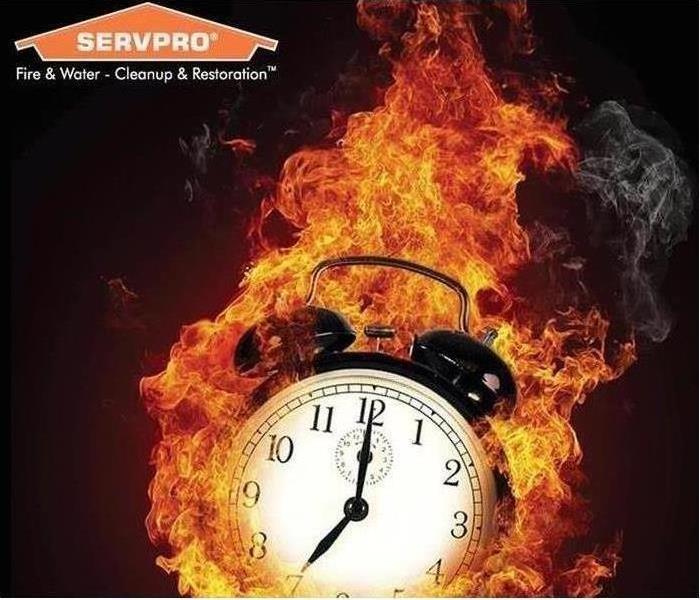 Where you have smoke you have fire!
Where you have smoke you have fire!
As the temperature has begun to drop we are seeing an uptick in the number of residential fires. 890 people die in winter home fires each year. $2 billion in property loss occurs each year from winter home fires. Winter home fires account for only 8 percent of the total number of fires in the U.S., but result in 30 percent of all fire deaths.
Winter brings several potential hazards into the home. Cooking is the leading cause of all winter home fires. Holiday decorations like faulty lights, dry Christmas trees, and candles are also a major cause. The top three days of the year for candle fires are Christmas, New Year’s Day and New Year’s Eve.
Faulty and improperly utilized alternative heating methods such as space heaters, fireplaces, and wood burning stoves also contribute not only to fire risk but carbon monoxide risk as well. Heating equipment is involved in one of every six reported home fires, and one in every five home fire deaths. Heating equipment is also a major source of carbon monoxide and winter months are when carbon monoxide incidents are more common.
Here are a few tips that you can share with your policy holders:
- Have your fireplace, heating vents and dryer vents inspected and cleaned by a professional every year.
- If you use your fireplace, make sure you clean after every use. Dispose of ashes correctly by placing them in a metal can at least ten feet from the house.
- Keep anything that can burn at least three feet from any heat source like fireplaces, wood stoves, radiators, or space heaters
- Plug only one heat-producing appliance (such as a space heater) into an electrical outlet at a time.
- If portable generators are needed, keep them outside, away from windows and as far away as possible from your home. Make sure someone is home to supervise.
- Install and test carbon monoxide alarms at least once a month.
- Keep your Christmas tree watered and dispose of it when it has become too dry. Nearly 40% of Christmas tree fires occur in January.
Here is a link to a great source of information https://www.nfpa.org/Public-Education/By-topic/Seasonal-fires/Put-A-Freeze-on-Winter-Fires
Please be safe and remember that if a problem does arrive, SERVPRO of La Grange Park / North Riverside is there 24/7/365 to help and make it "Like it never even happened."
We have a continuing education class coming up February 13. It is called Understanding Mold in the Restoration Industry and is going to be a great one. I have attached a flyer with more information. If you have a need for Ethics credit, please reach out to me as we are in the process of scheduling another class.
Finally, one request. If you have had a good experience with SERVPRO of Arlington Heights/Prospect Heights or SERVPRO of LaGrange Park/North Riverside please head over to our Yelp page or Google and give us a review. We truly appreciate everything you have done to help us grow!
https://twitter.com/SPArlProHeights https://www.facebook.com/SPArlingtonHtsProspectHts/ https://www.facebook.com/SPLagrangePKNRiverside/
Deep Fryer Fires
11/21/2018 (Permalink)
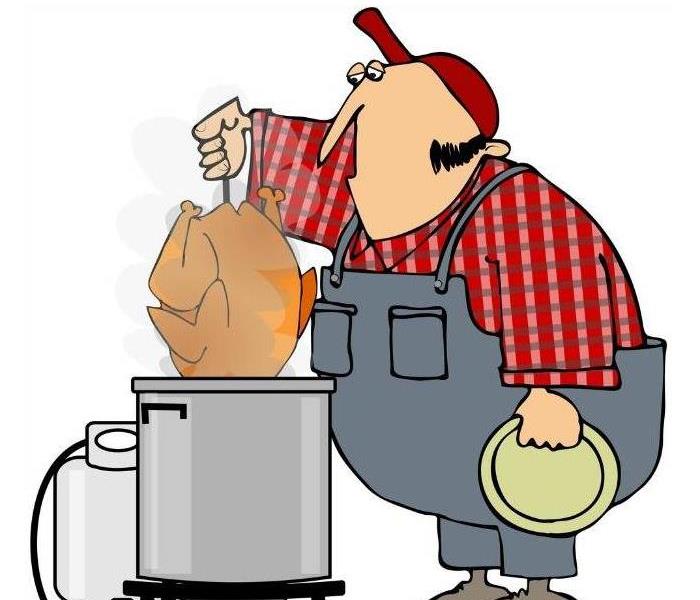 HAPPY THANKSGIVING!
HAPPY THANKSGIVING!
Keep the bird outside where it all started is going to be the best way to keep the bird from being the reason that you are staying in a hotel on and after Thanksgiving.
FACT: According to the National Fire Protection Association: deep fryer fires cause an average of 5 deaths, 60 injuries and more than $15 million in property damage each year. Deep-frying turkeys has become increasingly popular, but the new tradition is a recipe for holiday tragedy.
Deep Fryer Fires | FDNY Smart
www.fdnysmart.org/deep-fryer-fires/
Deep-Frying Outdoors
Although you’re outdoors, using a propane deep fryer can be very dangerous. Never leave your deep fryer unattended and be sure to carefully follow these instructions:
- To start, take the wrapper off of the turkey, and remove and discard the neck and giblets.
- Deep-fry your turkey outside on a flat surface, far away from homes, garages, wooden decks, etc.
- To determine how much oil is needed for frying, place the thawed turkey in the fryer basket and place it in the fryer. Add water until the top of the turkey is barely covered. Remove the turkey, allowing the water to drain from the turkey back into the fryer. Measure and mark the water line, and use that line as a guide when adding oil to the propane fryer.
- Pat the turkey dry with paper towels.
- Add oil to the fryer (based on the water line).
- Preheat oil in the fryer to 375° F.
- While the oil is heating, prepare your turkey with any seasonings, marinades, or injected flavor that you desire.
- When the oil is hot, turn the burner off and slowly lower the turkey into the hot oil. Slowly lowering the basket helps prevent the oil from bubbling over. Turn the burner back on.
- Cook the turkey about 3 to 4 minutes per pound.
- The turkey is done when the dark meat is at an internal temperature of 175° F to 180° F and all white meat is at an internal temperature of 165° F to 170° F.
- When the turkey is done, slowly lift it from the pot and place it in a pan or on paper towels to drain. Let the turkey stand for 20 minutes before removing it from the rack or basket.
- Let cool to a good eating temperature and ENJOY!
Smoke Detector Life Expectancy
8/3/2018 (Permalink)
You have a smoke detector in your home, but have you ever wondered what the life expectancy of that alarm is? Smoke alarms save lives. Smoke alarms that are properly installed and maintained play a vital role in reducing fire deaths and injuries, but how long before it should be replaced?
The U.S. Fire Administration for Homeland Security, the National Fire Protection Association (NFPA), the National Electrical Manufacturers Association (NEMA) and the Red Cross agree after working for 87,000 hours, or about 10 years in normal environmental conditions in the home can have an impact on the performance of your smoke alarm.
The NFPA conducted a study, and the results reinforced how important it is for integrators to address the fire safety needs of their clients: 1 in 5 Smoke Alarms Is 10+ Years Old
- Half of Americans (50 percent) have three or more smoke alarms in their current home.
- Almost one in five Americans who have smoke alarms (19 percent) say the oldest smoke alarm they currently have in their home is 10+ years old.
- Nearly one in five Americans who have smoke alarms (18 percent) are not at all sure how old the oldest smoke alarm they currently have in their home is.
- When asked how often they should replace smoke alarms, nine in 10 Americans (90 percent) did not select the correct answer, which is at least every 10 years.
SERVPRO of LaGrange Park/North Riverside wants you and your family safe. Keep these tips in mind when checking your smoke alarms.
Summertime Fire Safety
7/17/2018 (Permalink)
Now that it is summer, it is bonfire time! According to a report from the United States Fire Administration, summer is one of the most dangerous seasons for fire-related injuries and deaths. Fortunately, there are plenty of ways to protect yourself and your loved ones while still having a great time. Here are some great tips from the American Fire Safety Administration.
Choose a location for your bonfire where it will not spread. Never build a fire near any dry leaves or grassy areas or under overhanging tree branches. Before building a bonfire, clear away all shrubbery and vegetation from the area, dig a pit for the fire, and surround it with rocks.
Be smart about lighter fluid. Do not store gasoline, liquid fire starter, or any other type of flammable liquid near the campfire. It's too easy for stray flames to ignite these materials.
Never light a bonfire if you do not have the means of extinguishing it. Always keep plenty of water and a shovel near the campfire to use in an emergency and to put the campfire out when you are finished using it.
If you experience a fire at your home while enjoying a beautiful summer night, SERVPRO of LaGrange Park/North Riverside is here to help. Give us a call at 708-240-4873.
5 Fire Damage Restoration Tips
6/11/2018 (Permalink)
Fire damage can be very stressful time for your home or company. Here are some tips to remember in the event of fire and smoke damage to your home or business.
Repairing Smoke Damage to Walls
With fires there will always be a degree of smoke damage to your walls, wall paper and paint. If the smoke damage is not too serious, you should be able to scrub it clean with detergents and bleach. Note: soot from smoke damage is greasy stuff so you should always try to dust as much of it off from a surface before trying to scrub it clean. Often, you’ll want to repaint, but make sure all surfaces are clean and dry before painting.
Getting Rid of Mold & Mildew
Another huge issue in fire damage restoration is actually introduced by the water used to extinguish a fire. This problem is mold and mildew, and requires special attention. We highly recommend fire damage restoration professionals to deal with mold and mildew, because it can cause serious health problems, and can contaminate furniture, carpets, clothing, mattresses, walls and vents. The best thing you can do immediately is air out every room and clean out all vents and filters.
Repairing Flooring & Carpet
With all the water that is involved in putting out a fire, your floors and carpets will end up absorbing the worst of it. In almost every case, it’s recommended that you pull up any carpets that have water damage and replace them. Water can also seep underneath vinyl flooring and into cracks of hard wood, and will need to be addressed. If you have experience with flooring, you can lift it up and clean under them, but you may want to call a professional fire damage restoration company to assist you.
Cleaning Clothing
Cleaning smoke damage from clothing is one of the biggest jobs you’ll find after a fire. We’ve written a whole article on Restoring Clothing of Smoke Damage. Our biggest tip is to make sure you don’t smear the greasy soot into the clothing or just throw the smoky clothes into the wash. Often times dry cleaning is the best bet, and you should ask around local dry cleaners to see if any have experience with post-fire laundry.
Cleaning Dishes
Dishes are also important items to clean thoroughly after a fire because they will be in contact with your food and can cause health problems. Scrub all dishes well, let them soak in a solution of bleach and water (2 tablespoons of bleach per gallon) for at least 20 minutes and scrub some more for safety. When in doubt, if a dish, pot or pan won’t come clean, cut your losses and throw it out – (especially rubber or wooden dishes that absorb smoke).
SERVPRO of LaGrange Park/North Riverside are always here to help, If you have found your home or commercial property has had a fire give us a call at 708-240-2873 for all your restoration needs.
Soot Damage Tips
6/6/2018 (Permalink)
Soot and smoke damage is harmful to your health and will spread throughout the entire residence or building after a fire loss. Soot and smoke damage clean up is difficult because you will need to make sure that the soot is cleaned correctly so there is nothing harmful left behind. With smoke damage even a light coating of soot can be permanently embedded into items if professional restoration techniques are not used.
Below are some tips we tell our customers when they call in for fire damage, and soot damage to their home. They are not all inclusive in nature, and are not a substitute for professional services like what we provide.
Fire and Smoke Do's:
- Limit the movement in the home to prevent spreading and embedding soot particles.
- Clean and protect chrome trim on kitchen appliances with a light coating of petroleum jelly or other oil.
- Clean and coat any metal, brass, or copper that may be restored with oil.
- Blow off or brush-vacuum loose soot and particles from upholstery, carpeting and drapes.
- Open windows to begin to air out the property.
- Wash plants with water.
- Change the furnace filter (if the furnace is operating).
- Empty the refrigerator or freezer (if electricity is off) and prop doors open.
Don'ts:
- Do not attempt to clean or wash as absorbent surfaces i.e. walls, ceilings, etc.
- Do not use upholstered furniture.
- Do not use any food items that have been exposed to high heat or smoke.
- Do not use electronics until they have been professionally checked and cleaned.
SERVPRO of LaGrange Park/North Riverside takes care to insure that your soot and smoke damaged contents are restored properly to prevent further degradation of property or your health. Give us a call at 708-240-4873 for all your fire, smoke, and soot damage needs.
BBQ Safety Tips
5/28/2018 (Permalink)
It’s Memorial Day, and as we remember those who have given their lives for our freedom, we also enjoy spending time with friends and family. Let’s face it, most of that time is spent outside around the grill. According to the National Fire Protection Association (NFPA),” In 2014, 16,600 patients went to emergency rooms because of injuries involving grills”. The NFPA has listed several great tips for grill safety, we would like to share with you. You can also find other great tips at https://www.nfpa.org/Public-Education/By-topic/Seasonal-fires/Grilling/Grilling-safety-tips
- Grill outside and away from any structures
Charcoal and gas grills are designed for outdoor use only. However, NFPA reports that more than one-quarter (27 percent) of home fires started by outdoor grills began in a courtyard, terrace or patio, and 29 percent started on an exterior balcony or open porch. Pay attention to overhanging tree branches when you set up your grill.
- Make sure your grill is stable
Only set up your grill on a flat surface and make sure the grill can’t be tipped over. Consider using a grill pad or splatter mat underneath your grill to protect your deck or patio.
- Keep your grill clean
Remove grease or fat buildup from both the grill and the tray below the grill. If you are using a charcoal grill, allow the coals to completely cool off before disposing of them in a metal container.
- Check for propane leaks on your gas grill
Before the season’s first barbecue, check the gas tank hose for leaks by applying a light soap and water solution to the hose and then turning on the gas. If there is a propane leak, the solution will bubble. Other signs of a propane leak include the smell of gas near the barbecue or a flame that won’t light.
- If the flame goes out, wait to re-light
If you are using a gas grill and the flame goes out, turn the grill and the gas off, then wait at least five minutes to re-light it.
- Take care around the grill
Never leave a lit grill unattended. Don’t allow kids or pets to play near the grill. Never try to move a lit or hot grill, and remember the grill will stay hot for at least an hour after use.
- Be careful with charcoal starter fluid
If you use a charcoal grill, only use charcoal starter fluid. If the fire starts to go out, don’t add any starter fluid or any other flammable liquids to the fire. Consider using a charcoal chimney starter, which uses newspaper to start the fire instead of starter fluid.
- Wear the right clothing
Clothing can easily catch fire, so be sure your shirt tails, sleeves or apron strings don’t dangle over the grill.
- Be ready to put out the fire
Have baking soda on hand to control a grease fire and a fire extinguisher nearby for other fires. If you don’t have a fire extinguisher, keep a bucket of sand next to the grill. Never use water to put out grease fire.
Enjoy, relax, and most of all use these tips to stay fire safe. However, we all know accidents happen. If you should find you have a need for cleaning up after a fire event, SERVPRO of LaGrange Park/North Riverside is here to help make it “Like it never even happened.” Give us a call at 708-240-4873.
Warm Weather Fire Safety
5/2/2018 (Permalink)
Spring has sprung finally here in LaGrange Park, and it is time to get outside and enjoy the sun while it lasts. As you transition from sweaters to shorts, deep fryers to grills, and indoor holiday parties to backyard barbecues, keep an eye on these areas:
Grill Area- NFPA reports that an average of 8,900 home fires are caused by grilling each year. Here are some fire safety tips for the grill:
- While the meat is marinating, be sure to check each potentially problematic point of the grill including the propane tank, the hose, and all connecting points.
- Charcoal should be soaked with charcoal starter fluid only.
- Make sure the grill is clean, failing to clean the grill before and after use is a contributing factor in nearly 20% of all grill structure fires.
- Make sure the grill is set up in an open, outdoor area with nothing flammable (plants, paper products, etc.) nearby.
Outdoor Fire Pits
The necessary safety precautions for an outdoor fire pit are much the same as for a grill, plus a few others:
- Never leave young children unattended near a fire in the pit.
- Fill a bucket with water and set it next to the pit before you even begin building the fire.
- Avoid throwing leaves, pine cones, pine needles and paper into the fire. They catch fire quickly and can result in dangerous floating embers.
- Unless there’s an emergency, avoid dumping the entire bucket of water on the fire to put it out. Instead, spread the pieces of fuel as far apart as possible and gently sprinkle water over them until there are no more glowing embers. This prevents the scatter of embers and a thick cloud of smoke.
Chimneys
The NFPA recommends having a chimney inspected and thoroughly cleaned at least once a year anyway, and getting it out of the way this time of year often means ridding it of buildup that would only cause more damage if it hung around until the fall.
Smoke Alarms
As the spring and summer days progress, don’t forget to test the smoke alarms each month.
Dryers
The NFPA recommends cleaning out the vent pipe at least once a year. SERVPRO of LaGrange Park/North Riverside can help get the vents cleaned for you as well, give us a call at 708-240-4873.
Let’s enjoy these warmer spring days, and remember SERVPRO of LaGrange Park/North Riverside is here for you and all your restoration needs.
Fire Safety Tips for the Warmer Months
4/12/2018 (Permalink)
Spring has finally sprung in LaGrange Park! Time to start thinking about cleaning out all the built up clutter and stagnant air from the winter. That also means time to take stock of some things that may be a fire hazard around your home during your cleaning.
According to NFPA, the leading cause of home clothes dryer fires is failure to clean them. Lint catchers need to be cleaned before you throw in the next load of laundry. Another safety tip for around your dryer area is to keep all boxes, and other items that can catch on fire away from the dryer while it is in use.
Testing your smoke alarms saves lives. Gently vacuum or sweep the cob webs away from your smoke alarm. Remove anything that might be blocking the sensors. While you are up there, change your batteries as well.
The NFPA reports that an annual average of nearly 48,000 electrical fires occurred in U.S. homes between 2007 and 2011. Make sure to replace any electrical cords that are damaged or loose, and try to avoid running any cords under carpets or across doorways where they’re more likely to get damaged. Any cords with damaged plugins or unprotected wires should be discarded immediately.
Lastly, when working with, or disposing of, and potentially hazardous chemicals, never use the same container to mix them, which could cause a deadly reaction and check with your local municipality for disposal programs, or instructions on proper disposal methods.
SERVPRO of LaGrange Park/North Riverside wants you to have a safe and fun spring season. However, things happen, and if you experience a fire in your home, give us a call at 708-240-4873. We are always “Faster to any sized disaster”.
Candle Fire Safety
3/23/2018 (Permalink)
According to National Fire Safety Association, “Roughly one-third (36%) of home candle fires started in bedrooms. These fires caused 32% of the associated deaths and 47% of the associated injuries. Falling asleep was a factor in 11% percent of the home candle fires and 30% of the associated deaths. On average, 25 home candle fires were reported per day.”
Some safety tips to remember when burning a candle:
- Always keep a burning candle within sight. Extinguish all candles when leaving a room or before going to sleep. Be sure the wick ember is no longer glowing.
- Be sure the candle-holder is placed on a stable, heat-resistant surface. This can help prevent heat damage to underlying surfaces and prevent glass containers from breaking.
- Always burn candles in a well-ventilated room. Don’t burn too many candles in a small room or in a “tight” home where air exchange is limited.
- Place burning candles at least three inches apart from one another. This helps ensure they don’t melt one another, or create their own drafts to cause improper burning.
- Keep burning candles away from drafts, vents, ceiling fans and air currents. This will help prevent rapid, uneven burning, and avoid flame flare-ups and sooting. Drafts can also blow nearby lightweight items into the flame where they could catch fire.
- Use a snuffer to extinguish a candle. It’s the safest way to prevent hot wax splatters.
When putting out a candle fire, never extinguish candles with water. The water can cause the hot wax to splatter and might cause a glass container to break. Make sure that you have a fire extinguisher within reach. Never use water, as it will spread the fire. If you don't have a proper fire extinguisher nearby, use baking soda, sand or flour to extinguish the flames.
If you experience a fire in your home or business, give SERVPRO of LaGrange Park/North Riverside a call at 708-240-4873. We are always here to help.
Fireplace Safety
3/5/2018 (Permalink)
Winter is the perfect time to start up a fire in the fireplace, as an additional heating source in your home. However, if you are not careful the relaxing fire can turn into a fire hazard in your home. Here are some precautions we received from our friends at Travelers Insurance Company.
Keep Your Chimney Fireplaces and Wood Stoves Clean
Have your chimney, fireplace, wood or pellet stove inspected and cleaned by a licensed chimney specialist. They should be maintained annually to help ensure they are functioning safely and efficiently.
Be sure to keep the area around the hearth clear of debris, decorations and any other combustible materials.
If you have a wood burning, insert or pellet stove, refer to the manufacturer’s instructions for additional guidance related to operation and venting.
Keep Fires Burning Safely
Be sure the flue is open before lighting your fire to help ensure the fireplace will vent properly. Do not close your damper until you are sure the fire is out.
When starting a fire, only use a match or commercial firelighter. Never use flammable liquids to start a fire.
Glass doors of a fireplace should be kept open while burning a fire. This allows the fire to receive enough air for complete combustion and to help reduce creosote build-up in the chimney.
Metal mesh screens should remain closed whenever your fireplace is in use to help keep embers in the fireplace.
Only use dry wood in your fireplace. Wet wood can increase creosote buildup, which can lead to chimney fires.
Do not burn plastic because it can release toxic chemicals and cause damage to your chimney, fireplace or wood stove.
Never leave a fire in a fireplace unattended. Before leaving the house or going to bed, you should make certain to fully extinguish the fire.
Allow ashes to cool completely before disposing of them — ashes can take several days to cool completely. Never empty ashes directly into a trash can. Instead, place ashes in a covered metal container located at least 10 feet1 away from your home and any other building.
Keep the Outside of Your Home and Your Chimney Safe
Firewood should be stacked at least 30 feet away from your home.2
Your roof and chimney should be kept clean of leaves, pine needles and other debris. Prune trees and branches to keep them away from your chimney.
Install a chimney cap with spark arrester to help keep debris, leaves, branches and animals out, and to help prevent burning embers or sparks from escaping and creating a fire hazard.
Keep the Inside of Your Home Safe with Smoke and Carbon Monoxide Detectors
To help make your winter even safer, we recommend that you take the time to test your smoke and carbon monoxide detectors. A smoke detector is the most effective way to detect smoke from a fire and signal an alarm so that you can get you and your family out safely. A carbon monoxide detector can alert you to the buildup of this dangerous odorless and colorless gas. Make sure you test the detectors monthly, and after you change the batteries to ensure they work properly.
Source:
1 National Fire Protection Association. (2015). Wood and Pellet Stove Safety. PDF accessed from http://www.nfpa.org/safety-information/safety-tip-sheets.
2 National Fire Protection Association. (2015). Wildland Fire Safety. PDF accessed from http://www.nfpa.org/safety-information/safety-tip-sheets.
Fire Safety for the Elderly
2/7/2018 (Permalink)
The National Fire Protection Agency, advises that at age 65, people are twice as likely to be killed or injured by fires compared to the population at large. Approximately 12% of our population is made up of individuals 65 and older.
The Center of Disease Control has listed several tips for elderly fire safety.
- Keep it low
If you don't live in an apartment building, consider sleeping in a room on the ground floor in order to make emergency escape easier. Make sure that smoke alarmsare installed in every sleeping room and outside any sleeping areas. Have a telephone installed where you sleep in case of emergency. When looking for an apartment or high-rise home, look for one with an automatic sprinkler system. Sprinklers can extinguish a home fire in less time that it takes for the fire department to arrive. - Sound the alarm
The majority of fatal fires occur when people are sleeping, and because smoke can put you into a deeper sleep rather than waking you, it´s important to have a mechanical early warning of a fire to ensure that you wake up. If anyone in your household is deaf or if your own hearing is diminished, consider installing a smoke alarm that uses a flashing light or vibration to alert you to a fire emergency. View a list of product manufacturers. - Do the drill
Conduct your own, or participate in, regular fire drills to make sure you know what to do in the event of a home fire. If you or someone you live with cannot escape alone, designate a member of the household to assist, and decide on backups in case the designee isn't home. Fire drills are also a good opportunity to make sure that everyone is able to hear and respond to smoke alarms. - Open up
Make sure that you are able to open all doors and windows in your home. Locks and pins should open easily from inside. (Some apartment and high-rise buildings have windows designed not to open.) If you have security bars on doors or windows, they should have emergency release devices inside so that they can be opened easily. These devices won't compromise your safety, but they will enable you to open the window from inside in the event of a fire. Check to be sure that windows haven't been sealed shut with paint or nailed shut; if they have, arrange for someone to break the seals all around your home or remove the nails. - Stay connected
Keep a telephone nearby, along with emergency phone numbers so that you can communicate with emergency personnel if you're trapped in your room by fire or smoke.
If you or a loved one have fire damage in your home, please call SERVPRO of LaGrange Park/North Riverside at 708-240-4873. Let us help make it “Like it never even happened.”
Winter Fire Preventive Tips
1/12/2018 (Permalink)
According to the National Fire Protection Association, December, January, and February are the months that half the heating fires occur. Also in those same months, 1 and 7 fires heating equipment is reported as the cause of the fire. Space heaters are often the leading piece of equipment the source of the fires in this months. Almost 40% of the fires in December to February are space heater related.
Safety should always be a top consideration when using space heaters. Electrical Safety Foundation International has published several tips on safety while using a space heater.
- Make sure your space heater has the label showing that it is listed by a recognized testing laboratory.
- Before using any space heater, read the manufacturer’s instructions and warning labels carefully.
- Inspect heaters for cracked or broken plugs or loose connections before each use. If frayed, worn or damaged, do not use the heater.
- Never leave a space heater unattended. Turn it off when you're leaving a room or going to sleep, and don't let pets or children play too close to a space heater.
- Space heaters are only meant to provide supplemental heat and should never be used to warm bedding, cook food, dry clothing or thaw pipes.
- Install smoke alarms on every floor of your home and outside all sleeping areas and test them once a month.
- Proper placement of space heaters is critical. Heaters must be kept at least three feet away from anything that can burn, including papers, clothing and rugs.
- Locate space heaters out of high traffic areas and doorways where they may pose a tripping hazard.
- Plug space heaters directly into a wall outlet. Do not use an extension cord or power strip, which could overheat and result in a fire. Do not plug any other electrical devices into the same outlet as the heater.
- Place space heaters on level, flat surfaces. Never place heaters on cabinets, tables, furniture, or carpet, which can overheat and start a fire.
- Always unplug and safely store the heater when it is not in use.
Most of the U.S. is at risk for winter storms, which can cause dangerous and sometimes life-threatening conditions. Wind-driven snow, extreme cold, icy road conditions, downed trees and power lines can all wreak havoc to your home or commercial property. Home fires occur more in the winter than in any other season, and heating equipment is involved in one of every six reported home fires, and one in every five home fire deaths.
If you experience a fire, SERVPRO of LaGrange Park/North Riverside is here to help. Give us a call at 708-240-4873 for all your fire, smoke, and soot damage related needs. We work with your insurance companies to make your home look “Like it never even happened.”
Thanksgiving Fire Safety for the Kitchen
11/10/2017 (Permalink)
It’s that time of year again that we start thinking about gathering our family and friends in our homes to celebrate Thanksgiving. With that celebrating, the kitchen is certainly the heart of the home. It is also the perfect time to start thinking about your fire safety during all the chaos and hustle and bustle.
Thanksgiving by the numbers
- Thanksgiving is the peak day for home cooking fires, followed by Christmas Day and Christmas Eve.
- In 2015, U.S. fire departments responded to an estimated 1,760 home cooking fires on Thanksgiving, the peak day for such fires.
- Unattended cooking was by far the leading contributing factor in cooking fires and fire deaths.
- Cooking equipment was involved in almost half (48%) of all reported home fires and civilian and tied with heating equipment for the second leading cause of home fire deaths.
Source: NFPA's Fire Analysis & Research Division
The US Fire Safety Council give these safety tips to consider as well:
- Stay in the kitchen when you are cooking on the stovetop so you can keep an eye on the food.
- Stay in the home when cooking your turkey and check on it frequently.
- Keep children away from the stove. The stove will be hot and kids should stay 3 feet away.
- Make sure kids stay away from hot food and liquids. The steam or splash from vegetables, gravy or coffee could cause serious burns.
- Keep the floor clear so you don’t trip over kids, toys, pocketbooks or bags.
- Keep knives out of the reach of children.
- Be sure electric cords from an electric knife, coffee maker, plate warmer or mixer are not dangling off the counter within easy reach of a child.
- Keep matches and utility lighters out of the reach of children — up high in a locked cabinet.
- Never leave children alone in room with a lit candle.
- Make sure your smoke alarms are working. Test them by pushing the test button.
Frying your holiday turkey has now becoming a fun family tradition It's hard to beat the speed of deep-frying a turkey-or the irresistible flavor and juiciness that result. But turkey fryers have the potential to cause fire and serious injury. Our friends at State Farm have 15 great tips for frying your turkey safely:
- Keep outdoor fryers off decks, out of garages and a safe distance away from trees and other structures.
- Make sure the turkey is thawed and dry before cooking. Ice or water that mixes into the hot oil can cause flare-ups.
- Watch the weather. Never operate a fryer outdoors in the rain or snow.
- Place the fryer on a level surface, and avoid moving it once it's in use.
- Leave 2 feet between the tank and the burner when using a propane-powered fryer.
- Follow the manufacturer's instructions to avoid overfilling. Oil can ignite when it makes contact with the burner.
- Choose a smaller turkey for frying. A bird that's 8 to 10 pounds is best; pass on turkeys over 12 pounds.
- Never leave fryers unattended.
- Purchase a fryer with temperature controls, and watch the oil temperature carefully. Cooking oil that is heated beyond its smoke point can catch fire. If you notice the oil is smoking, turn the fryer off.
- Turn off the burner before lowering the turkey into the oil. Once the turkey is submerged, turn the burner on.
- Wear goggles to shield your eyes, use oven mitts to protect your hands and arms and keep a grease-rated fire extinguisher close by.
- Skip the stuffing when frying turkey, and avoid water-based marinades.
- Keep children and pets away from the fryer at all times.
- Once finished, carefully remove the pot from the burner, place it on a level surface and cover to let the oil cool overnight before disposing.
- Opt for an oil-less fryer. This uses infrared heat, rather than oil, to cook the turkey.
Remember these tips to keep your home fire safe this holiday season. SERVPRO of LaGrange Park/North Riverside wants to wish you a very Happy Thanksgiving! We are always here to help, give us a call at 708-240-4873 for all your fire restoration needs.
Firework Safety Tips For Your Fourth of July
6/27/2017 (Permalink)
Fireworks go with the Fourth of July like picnics, parades, and watermelon. However, you must use caution while lighting your fireworks. The National Fireworks Safety Council offers of some great safety tips when it comes to firework safety this Fourth of July.
- Parents should not allow young children to handle fireworks.
- Alcohol and fireworks do not mix. Save your alcohol for after the show.
- Do not hold a firework in your hand unless specifically stated in the caution label.
- Fireworks should only be used outdoors.
- Always have water ready, both in a bucket and in a charged hose, if you are using fireworks.
- Wear eye protection (safety glasses) whenever using fireworks.
- Only light one firework at a time.
- Never relight a "dud" firework. Wait 20 minutes and then soak it in a bucket of water.
According to the National Fire Protection Association, Fireworks start an average of 18,500 fires per year, including 1,300 structure fires, 300 vehicle fires, and 16,900 outside and other fires.
According to the Product Safety Commission, in 2015, U.S. hospital emergency rooms treated an estimated 11,900 people for fireworks related injuries; 51% of those injuries were to the extremities and 41% were to the head. Children younger than 15 years of age accounted for one-quarter (26%) of the estimated 2015 injuries.
Safety is an important key to having a fun holiday with your friends and family. Remember these safety tips, and have a very Happy Fourth of July.
Fire Safety for kids
6/9/2017 (Permalink)
Would you know what to do if a fire started in your home? Would your kids? According to NFPA, in 2013, 334 children died in home fires. Eighty-seven percent of all fire-related deaths are due to home fires, which spread rapidly and can leave families as little as two minutes to escape once an alarm sounds. Fires are not just a problem in the United States. In 2008, nearly 61,000 children around the world died due to a fire or burn.
Kids Health has some great tips for parents to review with their families about fire safety.
- Working smoke alarms reduce the chances of dying in a fire by nearly 50 percent. They are a critical first step for staying safe, but in order to be effective, they have to be working properly. For the best protection, install smoke alarms on every level of your home and in every sleeping area.
- Teach kids never to play with matches and lighters. Make a habit of placing these items up and away from young children.
- Create and practice a home fire escape plan with two ways out of every room in case of a fire. Get a stopwatch and time how fast your family can escape. The kids will love it.
- Children should know how to respond to the sound of a smoke alarm. Teach them to get low and get out when they hear it. A child who is coached properly ahead of time will have a better chance to be safe.
- Use common sense in the kitchen. Limit distractions when cooking and don’t leave a hot oven or stove top unattended.
- Blow out candles before you leave the room or before you go to sleep.
In the event of a fire in your home, follow these safety tips to keep your family safe. Then after all family members are taken care of, and the fire department has cleared your home, call SERVPRO of LaGrange Park/North Riverside at 708-240-4873. We are always here to help!
Know When To Stop Drop and Roll
6/9/2017 (Permalink)
"Stop, drop, and roll” is used when clothing catches fire. It is very important we teach our children the dangers of fire, and what to do if an article of their clothing catches on fire.
The NFPA, teaches the following method:
-Stop where you are.
- Drop to the ground and cover your eyes and mouth with your hands.
- Roll over and over and back and forth until the flames are out.
- Get help from a grown-up who will cool the burn and get medical help.
The NFPA also emphasizes that we need to teach our children DO NOT RUN!
eMediaWorks also has a wonderful video that you can show your children to teach them how to "Stop, Drop, & Roll". Please watch this video with your family, and educate them on the importance of fire safety Stop, Drop, and Roll.
SERVPRO of LaGrange Park/North Riverside is always here to help. If you have a fire in your home of business give us a call at 708-240-4873.
Summer Fire Safety Tips
6/1/2017 (Permalink)
Summer is here, and for many of us that means s'mores roasting on the fire pit, and supper cooking on the BBQ grill. However, it should also mean that we are taking a look at some summer time fire safety as well.
The American Red Cross has some simple safety tips for every family to consider:
- Always supervise a barbecue grill when in use.
You don’t want to burn that cheeseburger that’s waiting for you!
- Never grill indoors – not in the house, camper, tent, or any enclosed area.
Take advantage of the beautiful weather and cook outside.
- Make sure everyone, including the pets, stays away from the grill.
Your guests might be hungry but they still have to wait until the food is off the grill to get their hands on it!
- Keep the grill out in the open, away from the house, the deck, tree branches, or anything that could catch fire.
Keep the party going and use these safety precautions while cooking.
- Use the long-handled tools especially made for cooking on the grill to keep the chef safe.
Provide the chef with the right tools to keep their hands safe so they can participate in the post-barbecue volleyball game.
Here's to a safe and happy summer from your friends at SERVPRO of LaGrange Park/North Riverside.
What happens after your Chicago area fire?
6/1/2017 (Permalink)
We all know that for an emergency you call 911, but what happens after the fire department leaves and you have a damaged home or business? You call SERVPRO of LaGrange Park/North Riverside, that's what you do! We are here to help you 24/7/365. Give us a call at 708-240-4873 for all your fire and water emergency needs.
Fires can leave behind soot and smoke that needs to be cleaned. SERVPRO of LaGrange Park/North Riverside is here to help! Cleaning up after soot and smoke is no small task, but our trained staff will be able to clean your home or commercial property and return it to you just "Like it never even happened." We are here to help 24/7/365 for all your restoration needs.
SERVPRO of LaGrange Park/North Riverside Fire Continuing Education Class
5/31/2017 (Permalink)
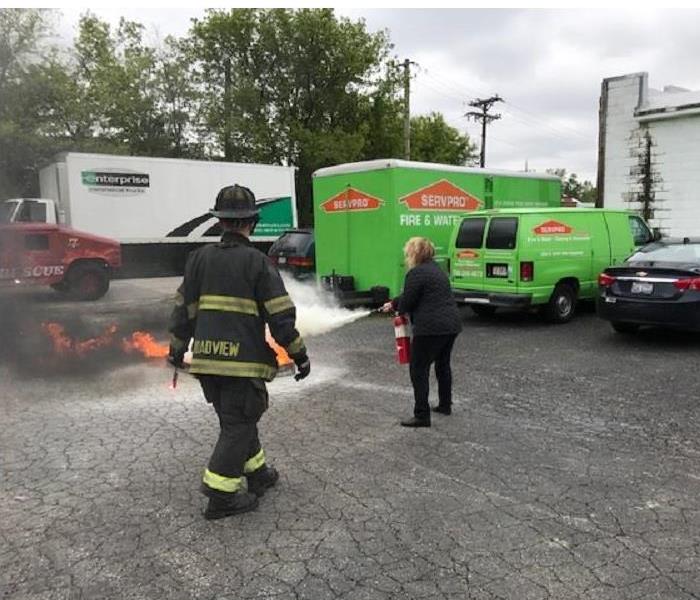 Fire Inspector, Anthony Monks provides hands on training for fire extinguishers and their proper use.
Fire Inspector, Anthony Monks provides hands on training for fire extinguishers and their proper use.
On May 24, 2017 SERVPRO of LaGrange Park/North Riverside hosted a continuing education class for our insurance agents on fire damage to home and commercial properties.
The Broadview Fire Department was also onsite to give a demonstration on fire extinguishers and their proper use. Fire Inspector, Anthony Monks, did an amazing job with the hands on demonstration. Each agent had the opportunity to put out a fire that was closely monitored by the fire inspector.
Like us on Facebook for more pictures and video from this class and all our other activities:
https://www.facebook.com/SPLagrangePKNRiverside/?pnref=lhc
If you have a fire in your home, remember to call SERVPRO of LaGrange Park/North Riverside at 708-240-4873. We are "Faster to Any Size Disaster"!
Smoke and Soot Cleanup
5/30/2017 (Permalink)
 Smoke and Soot Damage Can Cause a Pervasive Odor in Your Home.
Smoke and Soot Damage Can Cause a Pervasive Odor in Your Home.
Smoke and soot is very invasive and can penetrate various cavities within your home, causing hidden damage and odor. Our smoke damage expertise and experience allows us to inspect and accurately assess the extent of the damage to develop a comprehensive plan of action.
Smoke and soot facts:
- Hot smoke migrates to cooler areas and upper levels of a structure.
- Smoke flows around plumbing systems, seeping through the holes used by pipes to go from floor to floor.
- The type of smoke may greatly affect the restoration process.
Different Types of Smoke
There are two different types of smoke–wet and dry. As a result, there are different types of soot residue after a fire. Before restoration begins, SERVPRO of LaGrange Park/North Riverside will test the soot to determine which type of smoke damage occurred. The cleaning procedures will then be based on the information identified during pretesting. Here is some additional information:
Wet Smoke – Plastic and Rubber
- Low heat, smoldering, pungent odor, sticky, smeary. Smoke webs are more difficult to clean.
Dry Smoke – Paper and Wood
- Fast burning, high temperatures, heat rises therefore smoke rises.
Protein Fire Residue – Produced by evaporation of material rather than from a fire
- Virtually invisible, discolors paints and varnishes, extreme pungent odor.
Our Fire Damage Restoration Services
Since each smoke and fire damage situation is a little different, each one requires a unique solution tailored for the specific conditions. We have the equipment, expertise, and experience to restore your fire and smoke damage. We will also treat your family with empathy and respect and your property with care.
Have Questions about Fire, Smoke, or Soot Damage?
Call Us Today – 708-240-4873.
Tips for holiday fire safety
11/30/2016 (Permalink)
Per the National Fire Protection Association, nearly 47,000 fires occur during the winter holidays claiming more than 500 lives, causing more than 2,200 injuries, and costing $554 million in property damage. The National Fire Protection Association also states that on average, one of every 22 home fires started by Christmas trees result in death.
www.redcross.org/homefires, has several good home safety tips for the holidays to keep your home safe. We at SERVPRO LaGrange Park/North Riverside wanted to share some of those tips with you to ensure a safe holiday season.
- Place Christmas trees, candles, and other holiday decorations at least three feet away from heat sources like fireplaces, portable heaters, radiators, heat vents and candles.
- Purchase flame retardant metallic or artificial trees. If you purchase a real tree, make sure that it has fresh, green needles that aren’t easily broken. Keep live trees as moist as possible by giving them plenty of water.
- Make sure that light strings and other holiday decorations are in good condition. Do not use anything with frayed electrical cords and always follow the manufacturer’s instructions.
- Always unplug tree and holiday lights before leaving home or going to bed.
- Never use lit candles to decorate a tree. Always extinguish candles before leaving the room orgoing to bed.
- Use only sturdy tree stands designed not to tip over. Keep curious pets and children away from Christmas trees.
- Keep anything that can catch on fire—pot holders, oven mitts, wooden utensils, paper or plastic bags, food packaging, and towels or curtains—away from your stove top.
- Designate one person to walk around your home to make sure that all candles and smoking materials are properly extinguished after guests leave.
The following video also shares other great ideas to keep in mind this holiday season.
Holiday Fire Safety
Have a safe and wonderful holiday season from your friends at SERVPRO LaGrange Park/North Riverside






 24/7 Emergency Service
24/7 Emergency Service

